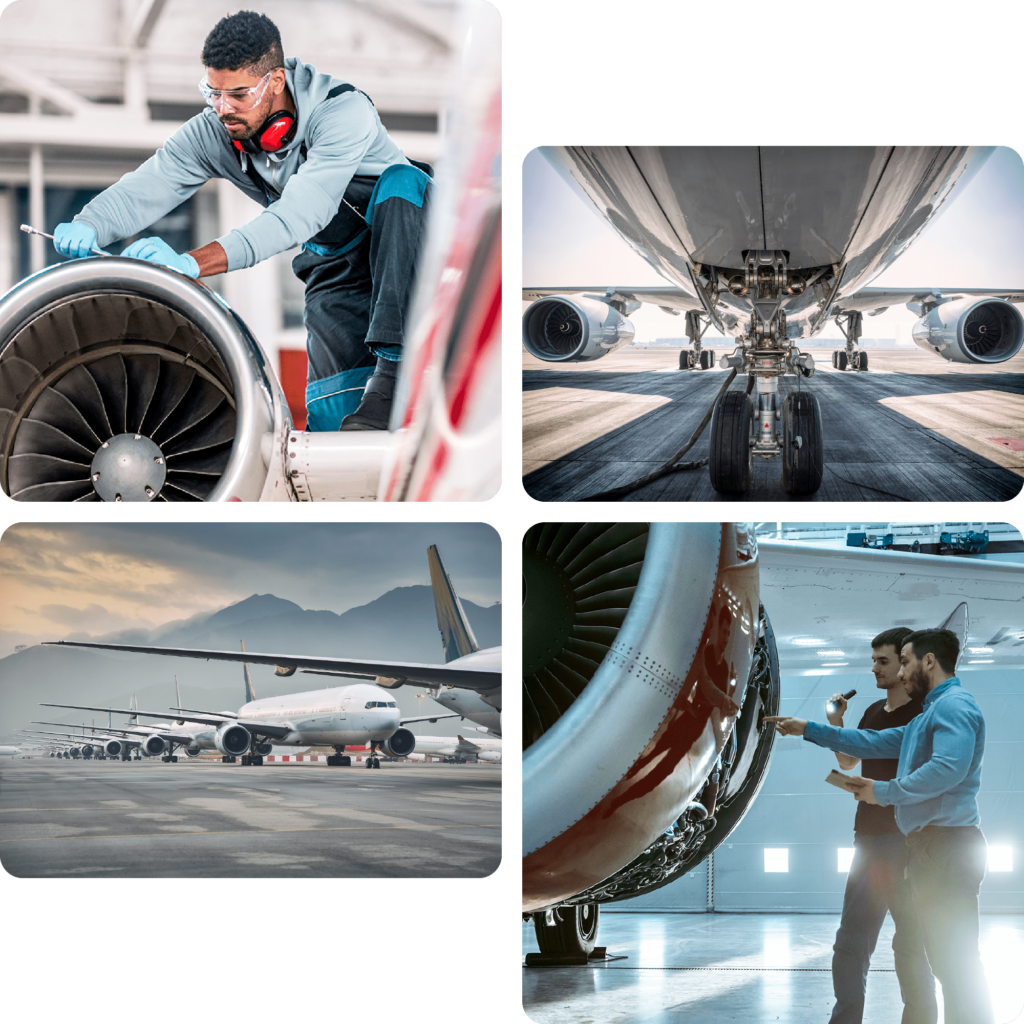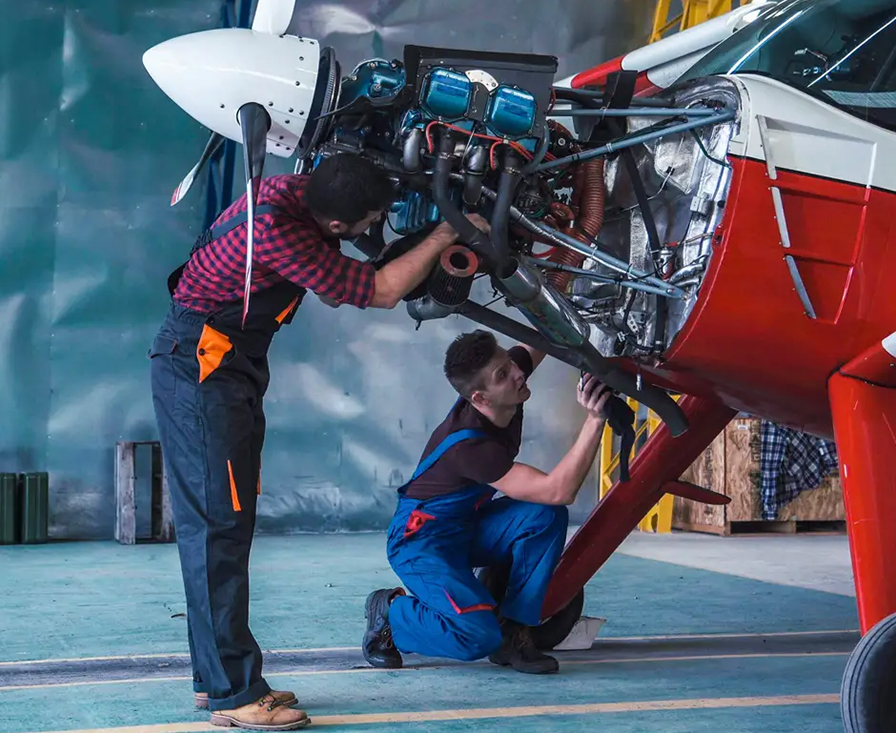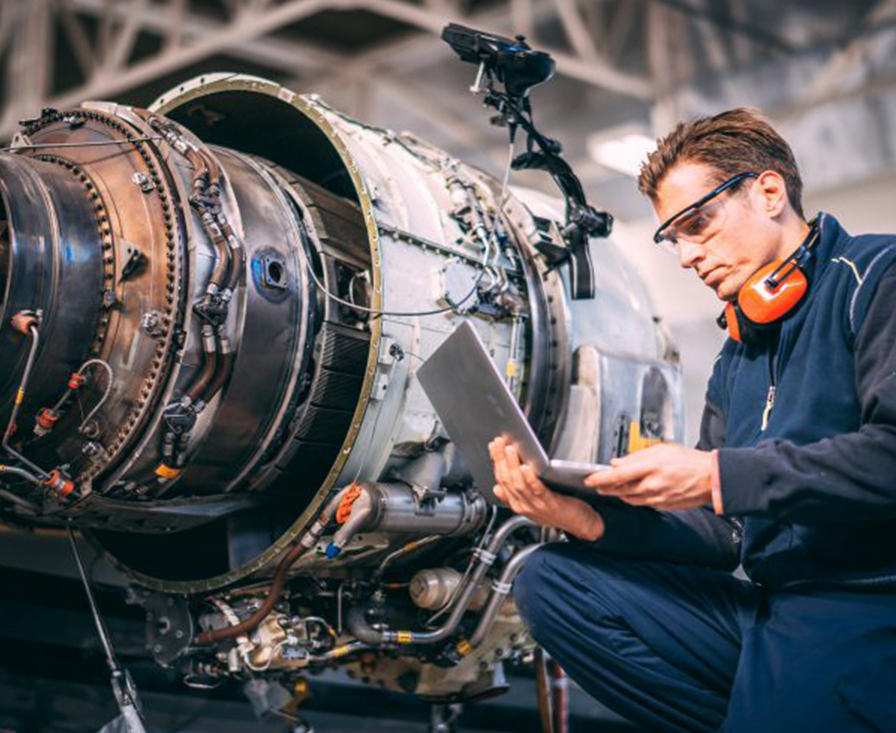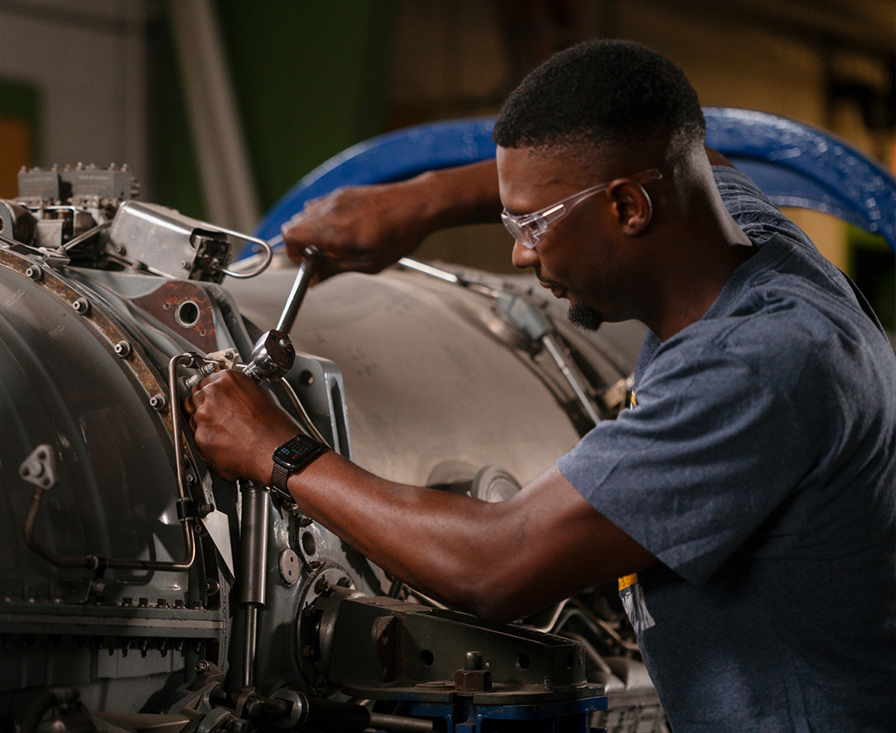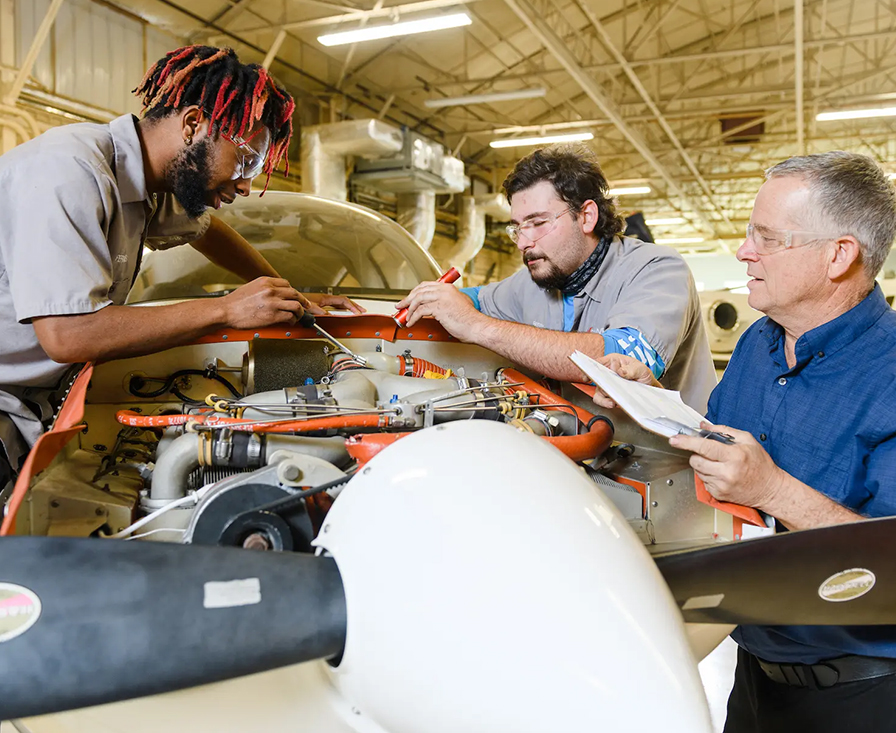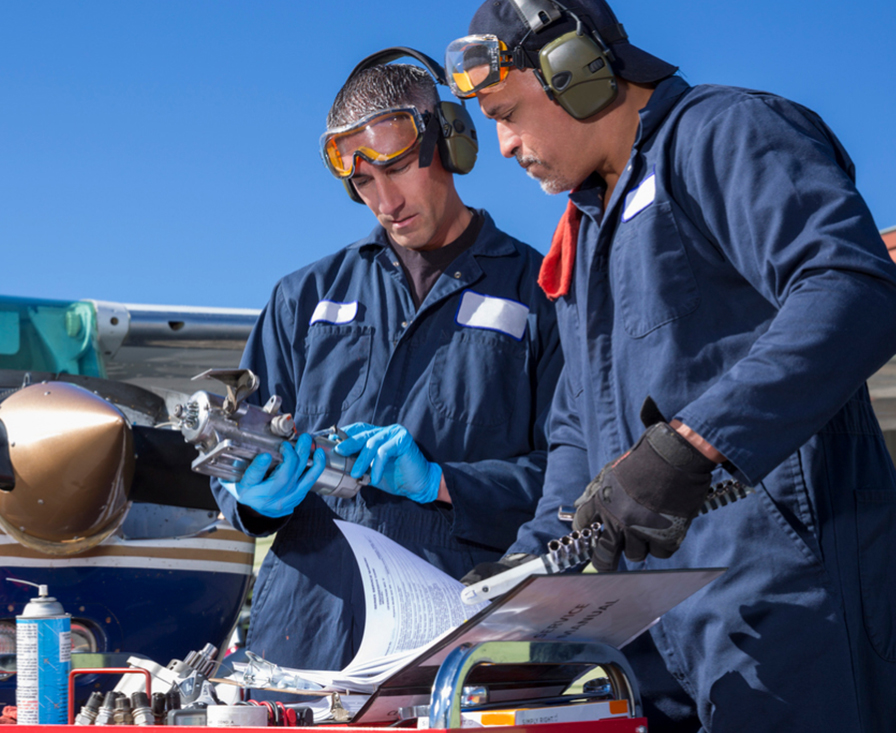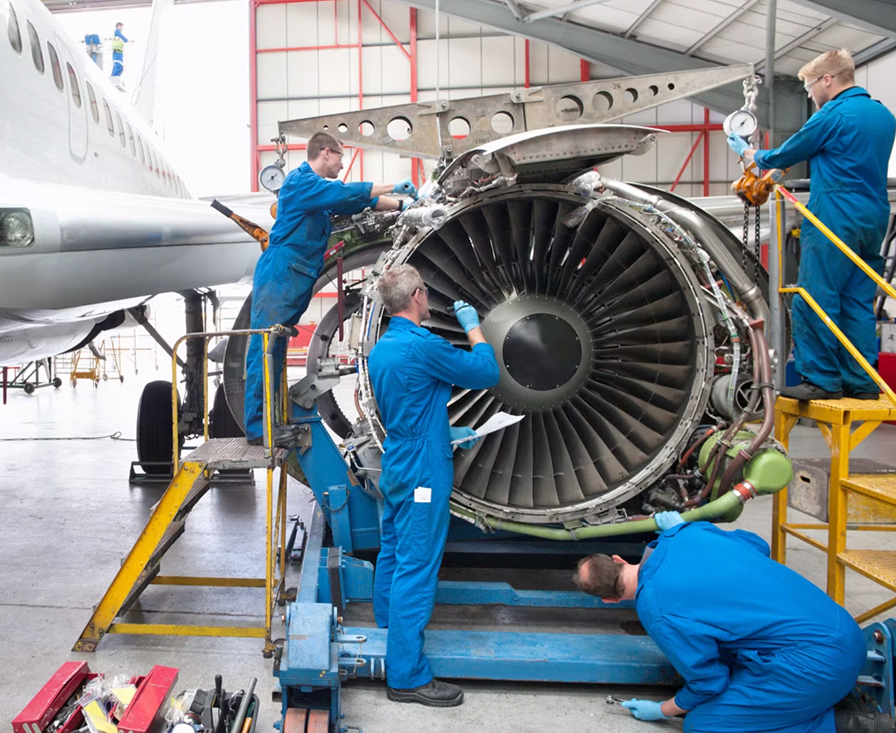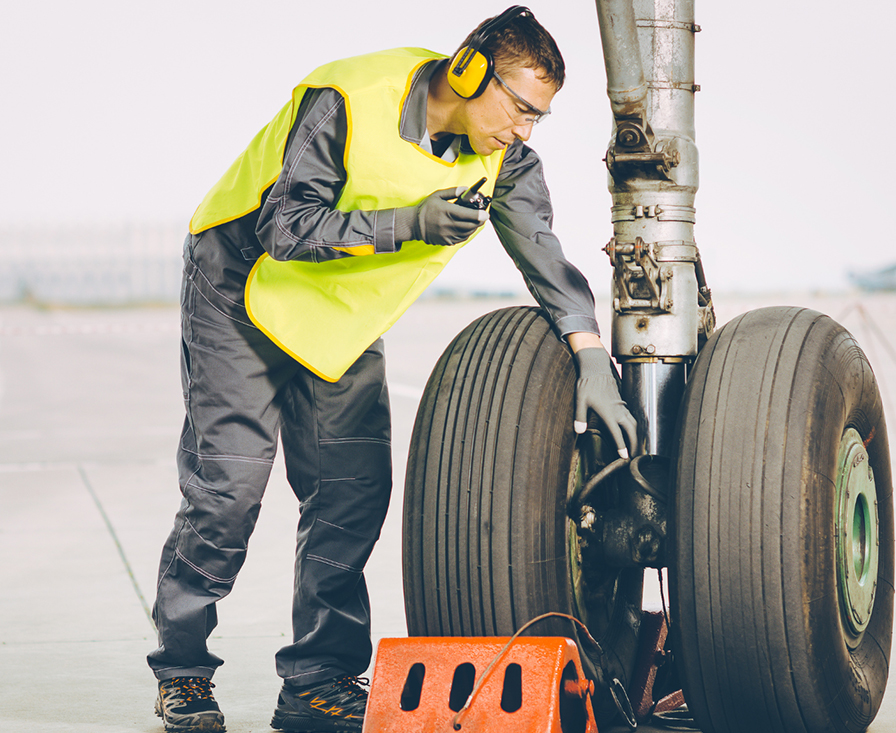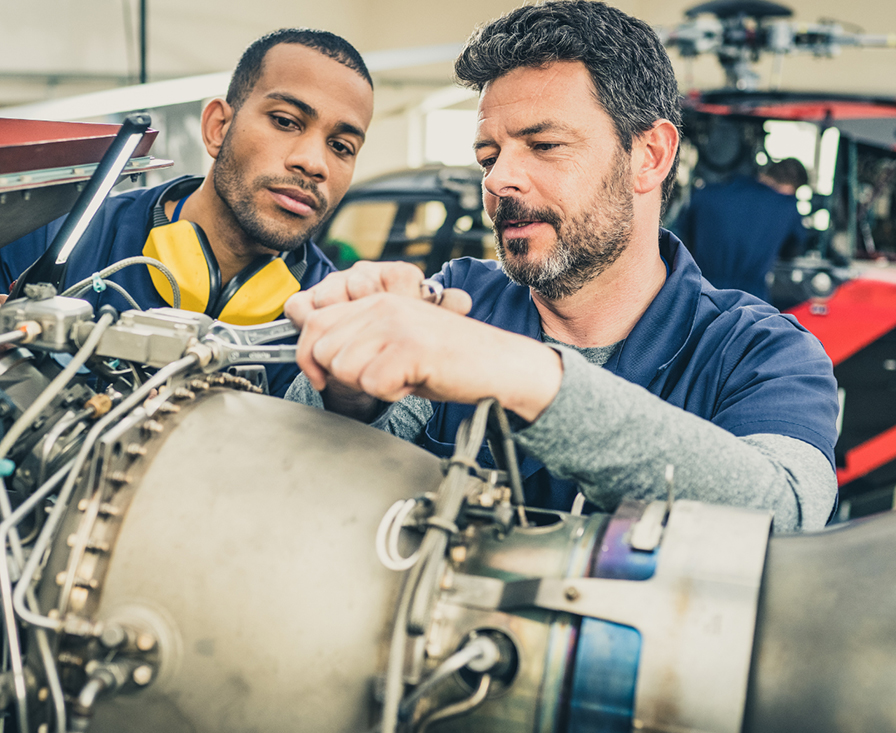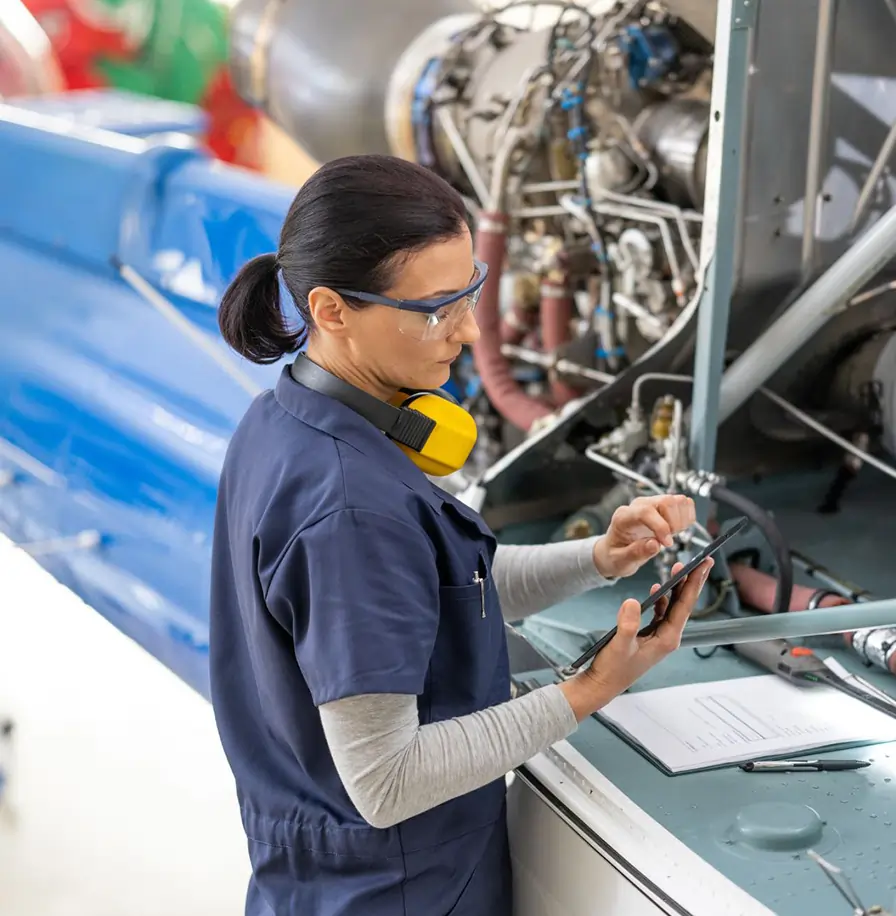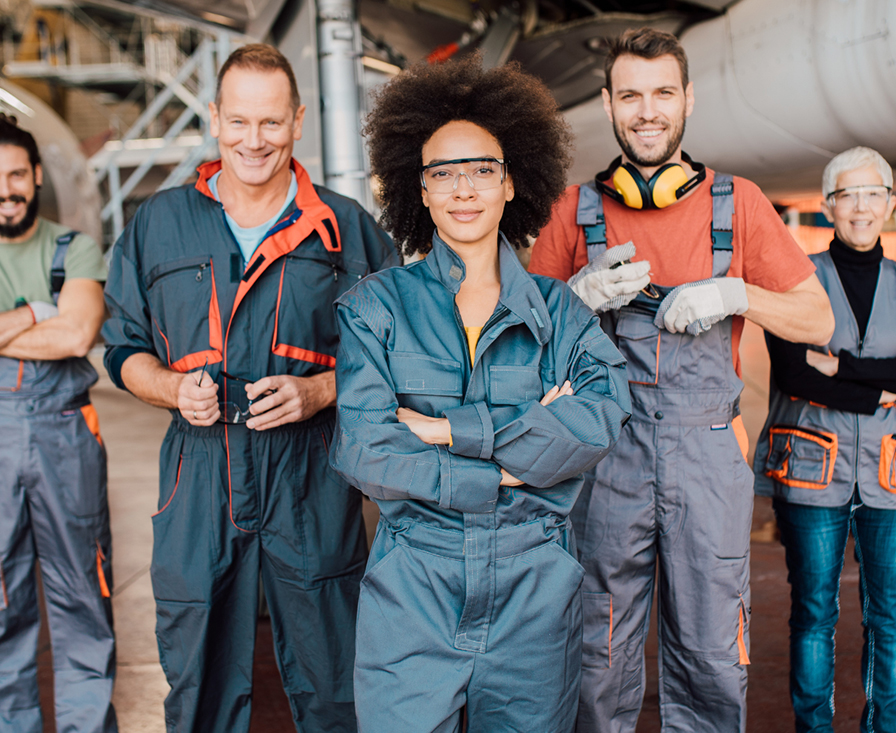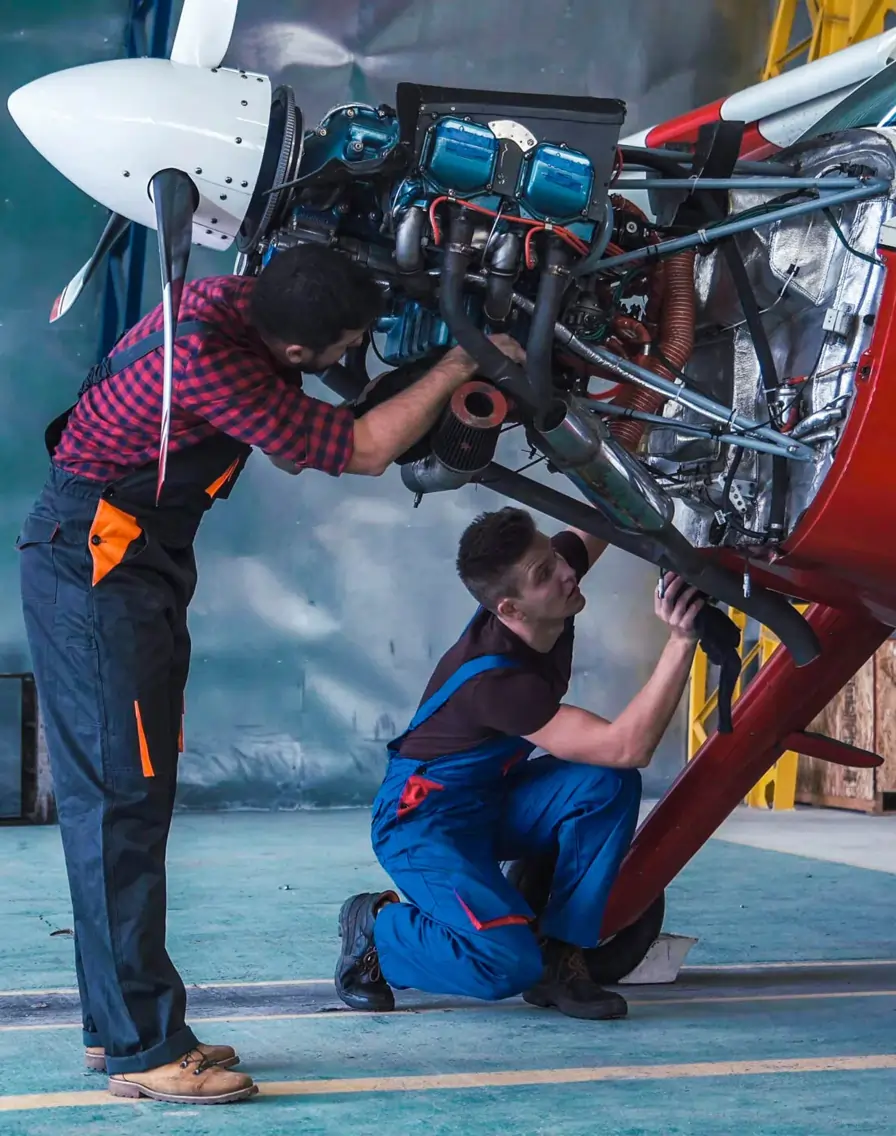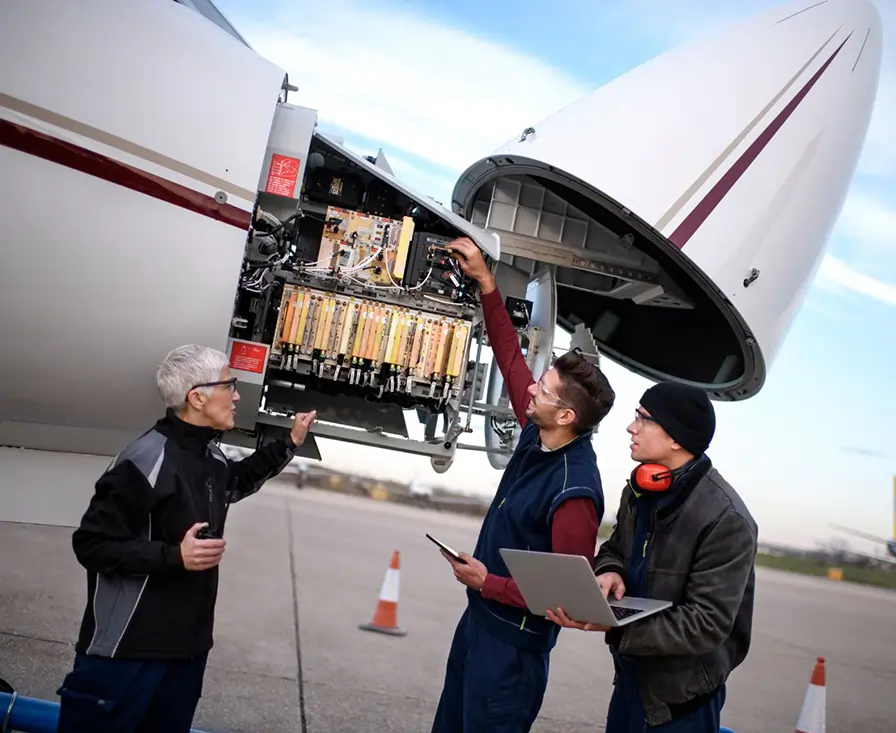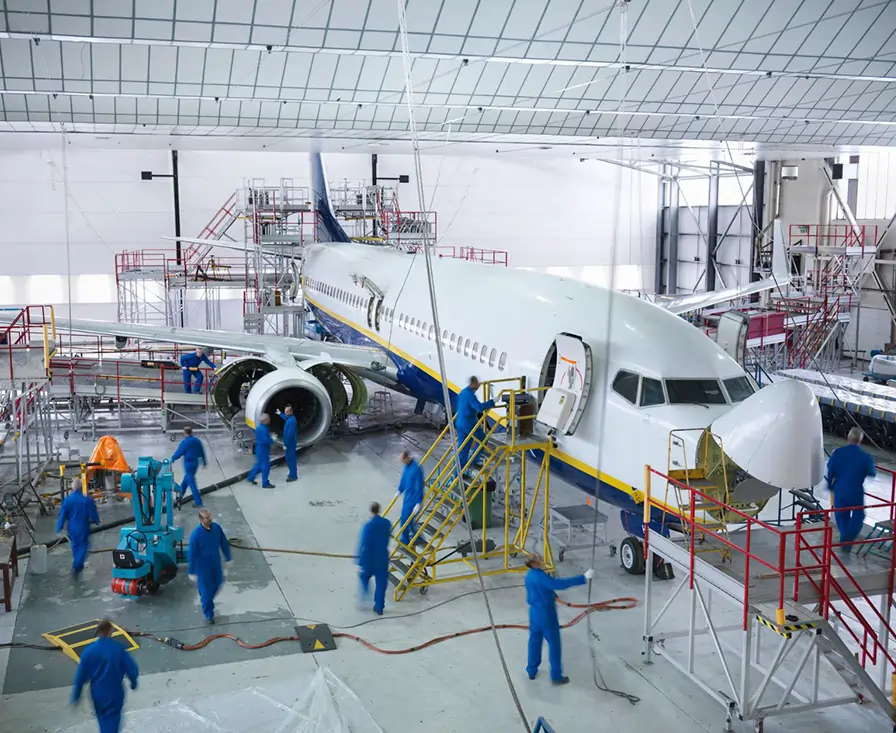With a robust network of 50 campuses across the Philippines, Mechanic School ensures accessibility to top-notch aviation training. This widespread presence allows students to choose a location that best fits their needs and ensures consistent, high-quality education regardless of where they are based.
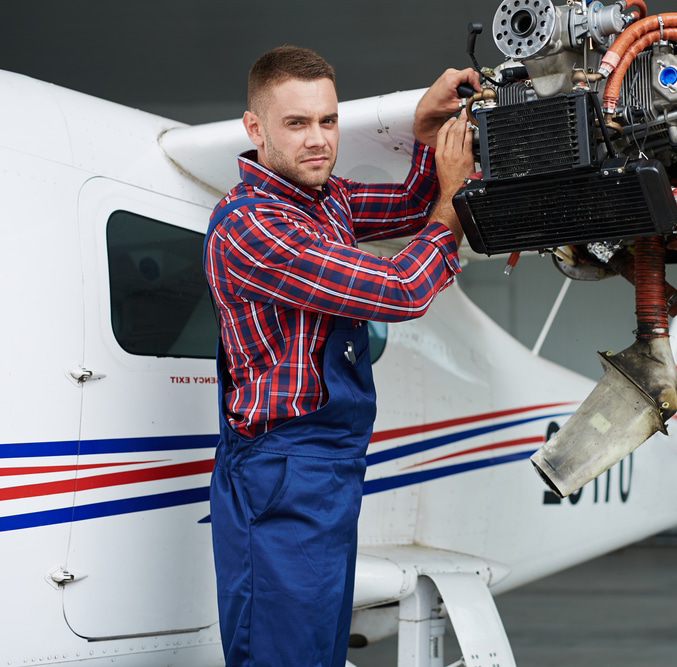
Our Courses
Aircraft Maintenance Technology (TECHNICIAN)
Our comprehensive Aircraft Maintenance Technology program equips students with the skills and knowledge needed to maintain and repair various types of aircraft. This program covers essential aspects such as airframe and powerplant maintenance, ensuring graduates are industry-ready. Learn MoreAviation Electronics Technology (AVIONICS)
Our Aviation Electronics Technology program focuses on the installation, troubleshooting, and maintenance of aircraft electronic systems. Students receive hands-on training in avionics, preparing them for careers in the rapidly evolving field of aviation electronics.Learn MoreWant to find out more about our Aviation Mechanic Courses?
Why aircraft maintenance and technology?
Demand Surge
Aircraft maintenance and technology are in high demand due to the rapid expansion of the aviation industry. Skilled technicians trained in aircraft maintenance technology and aviation maintenance technology are essential to ensure the safety and efficiency of air travel, making this a lucrative and stable career choice.
Robust Programs
Our aircraft mechanic schools offer comprehensive aircraft maintenance classes and aeroplane mechanic courses. These programs, including our aeronautical mechanic course and plane mechanic training, provide hands-on experience and theoretical knowledge, ensuring graduates are well-equipped to excel in the aviation maintenance technology field.
Career Diversity
A career in aviation maintenance technology opens doors to diverse opportunities. From working with major airlines to private jets and military aircraft, the skills acquired through our aircraft mechanic program and aeroplane maintenance courses prepare you for a wide range of roles within the aviation industry.
Future Investment
Investing in an education in aircraft maintenance technology is investing in your future. Our aircraft maintenance technology 2-year programs and aviation mechanic courses are designed to provide long-term career growth and stability, ensuring you remain in demand as aviation technology continues to advance.
Global Recognition
Graduates from our aircraft mechanic schools and airplane mechanic programs are recognized worldwide for their expertise. Our aviation mechanic career pathways ensure that you are not only qualified locally but also possess the credentials to work in international aviation maintenance roles, making you a valuable asset globally.
State-of-the-Art Facilities
At Aero Wave Aviation and Maintenance School, we pride ourselves on offering state-of-the-art training facilities equipped with the latest technology and tools. Our advanced training environments simulate real-world conditions, providing you with the practical skills and experience needed to excel in the dynamic field of aviation maintenance.
Potential Aviation Careers
Aircraft Mechanic
An aircraft mechanic is a skilled professional trained through an aircraft mechanic program to inspect, repair, and maintain airplanes. They play a crucial role in ensuring the safety and efficiency of aircraft. Comprehensive aircraft mechanic courses and aeroplane mechanic classes provide the necessary knowledge and skills for this career.
Aircraft Maintenance Technician
An aircraft maintenance technician focuses on the detailed upkeep and repair of aircraft, ensuring all components meet safety standards. Training typically involves aviation maintenance technology programs and aircraft maintenance classes to master the intricacies of aircraft systems and maintenance protocols.
Aircraft Technician
An aircraft technician is responsible for performing routine checks and repairs on aircraft. This role requires in-depth knowledge from aviation mechanic courses and plane mechanic training. Technicians are vital for maintaining the airworthiness of planes, working closely with pilots and other maintenance staff.
Aircraft Maintenance Supervisor
An aircraft maintenance supervisor coordinates the daily activities of maintenance personnel, ensuring efficient workflow and adherence to safety protocols. This role involves experience in aviation maintenance technology and strong organisational skills, often gained through aircraft maintenance technology 2-year programs.
Aviation Maintenance Technician
An aviation maintenance technician performs regular maintenance and emergency repairs on aircraft. Their training, often from aviation maintenance courses and aircraft mechanic schools, ensures they are well-versed in diagnosing mechanical issues and implementing solutions to keep aircraft operational and safe.
Helicopter Mechanic
A helicopter mechanic is trained specifically in the maintenance and repair of helicopters. This role involves specialised knowledge gained from aeronautical mechanic courses and aviation maintenance technology programs. Helicopter mechanics ensure the airworthiness of rotorcraft, focusing on unique systems and components not found in fixed-wing aircraft.
Why Choose Aero Wave Aviation and Maintenance School?

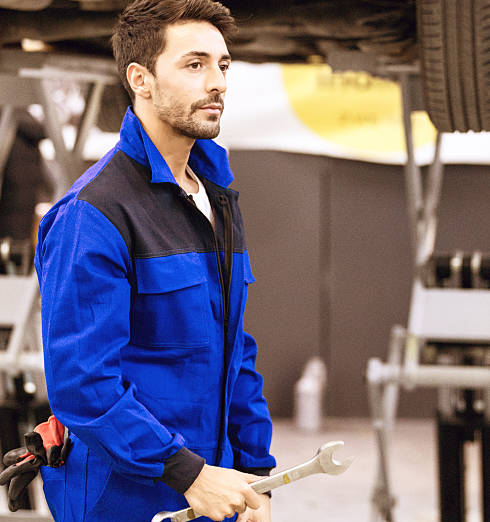
Support Services
We Put Our Students First
At Aero Wave Aviation and Maintenance School, we prioritise our students' success and well-being. Our comprehensive support services are designed to ensure that every student enrolled in our aircraft maintenance technology programs thrives academically and professionally. We offer personalised academic advising, career counselling, and job placement assistance to guide you through your aviation mechanic career. Our experienced instructors provide one-on-one mentoring, and our state-of-the-art facilities offer hands-on training in aircraft maintenance technology, airplane mechanic classes, and aviation maintenance courses. We are committed to helping you achieve your goals and excel in the dynamic field of aviation maintenance technology.
Career Pathways
We do not provide jobs, we INITIATE CAREERS
At Aero Wave Aviation and Maintenance School, we prioritise launching careers, not just jobs. Our comprehensive aircraft maintenance technology programs, including aircraft mechanic classes and aviation mechanic courses, provide students with the skills needed for a successful aviation mechanic career. With a focus on hands-on experience, our aeronautical mechanic course and plane mechanic training ensure graduates are prepared for the demands of the industry. Whether you’re enrolled in our airplane mechanic program or taking aircraft maintenance classes, we offer a clear path from education to employment. Join us at our aircraft mechanic schools and start your journey towards a fulfilling career in aviation.



Testimonial
Our Customer Feedback
Our Graduates are Working in Following Organisations
A Comprehensive Guide to Pursuing an Aviation Mechanic Career at Aero Wave Aviation and Maintenance School
What is an Aircraft Mechanic School?
An aircraft mechanic school is a specialised educational institution dedicated to training individuals in the field of aircraft maintenance and technology. These schools offer comprehensive programs designed to equip students with the knowledge and skills necessary to become proficient aviation mechanics. At Aero Wave Aviation and Maintenance School, our aircraft mechanic programs are designed to provide a thorough understanding of aviation maintenance technology, combining theoretical knowledge with hands-on training to prepare students for successful careers in the aviation industry.
Our aircraft mechanic school offers an array of programs, including aircraft mechanic courses, airplane mechanic classes, and aviation maintenance courses. These programs cover a broad spectrum of topics such as aircraft systems, engines, avionics, and airframe maintenance. Students will learn about the intricate details of airplane mechanic courses and gain practical experience through aircraft maintenance technology labs and workshops.
The training at our airplane mechanic school is designed to meet the rigorous standards of the aviation industry, ensuring that graduates are well-prepared for the demands of their careers. The curriculum is structured to provide a comprehensive education in aircraft maintenance technology, including hands-on practice in aircraft maintenance classes and aviation mechanic career preparation.
Our aircraft mechanic program is designed to be completed in a structured timeframe, typically spanning 2 years. This allows students to gain in-depth knowledge and practical experience while preparing for certification exams. Upon completion, graduates are well-equipped to pursue various career paths in aviation, including positions as aeronautical mechanics, plane mechanics, and other specialised roles within the industry.
In summary, an aircraft mechanic school like Aero Wave Aviation and Maintenance School provides a detailed and practical education in aircraft maintenance technology. It prepares students for successful careers in aviation by offering a range of courses and hands-on training opportunities to ensure they are fully equipped for the challenges of the field.
What Courses?
At Aero Wave Aviation and Maintenance School, we offer a diverse range of aircraft mechanic courses and airplane mechanic classes designed to provide students with a comprehensive understanding of aviation maintenance technology. Our curriculum includes both theoretical instruction and practical training, ensuring that students gain the knowledge and skills needed for a successful aviation mechanic career.
Our aircraft mechanic program features several key courses:
- Aircraft Maintenance Technology 2 Years: This course is a comprehensive program designed to provide students with a deep understanding of aircraft maintenance technology. Over the span of 2 years, students will cover topics such as aircraft systems, engines, avionics, and airframe maintenance. The course includes both classroom instruction and hands-on training, allowing students to apply their knowledge in real-world scenarios.
- Aviation Maintenance Technology: This course covers the essential principles and practices of aviation maintenance technology, focusing on aircraft systems, maintenance procedures, and safety protocols. Students will learn about the various components of aircraft and how to perform maintenance tasks efficiently and effectively.
- Aeronautical Mechanic Course: This course is tailored for those interested in becoming aeronautical mechanics. It provides specialised training in the maintenance and repair of aircraft, including detailed instruction on engine systems, avionics, and airframe components.
- Aircraft Mechanic Classes: These classes offer focused training on specific aspects of aircraft maintenance, including engine repair, avionics systems, and airframe inspections. Students will gain practical experience through hands-on labs and workshops.
- Airplane Mechanic Program: This program provides comprehensive training in airplane mechanic courses, covering all aspects of aircraft maintenance from basic principles to advanced techniques. Students will receive a well-rounded education in aircraft systems and maintenance procedures.
- Plane Mechanic Training: This course focuses on the practical aspects of plane mechanic training, including hands-on experience with aircraft systems, tools, and maintenance procedures. Students will learn how to perform routine inspections and repairs on various types of aircraft.
In addition to these courses, we offer various other programs and classes designed to meet the needs of aspiring aviation mechanics. Our curriculum is designed to ensure that students are fully prepared for certification exams and ready to embark on a successful career in the aviation industry.
Overall, our aircraft mechanic courses, and airplane mechanic classes are designed to provide a thorough education in aviation maintenance technology, equipping students with the skills and knowledge needed to excel in their careers as aircraft mechanics.
What skills will I learn in the aircraft mechanic program?
In the Aircraft Mechanic Program at Aero Wave Aviation and Maintenance School, you’ll acquire a comprehensive skill set essential for a successful aviation mechanic career. This program is meticulously designed to provide you with hands-on experience and theoretical knowledge in aircraft maintenance and technology.
- Fundamental Aircraft Maintenance Technology: You will gain a deep understanding of aircraft maintenance technology, including the operation and maintenance of various aircraft systems. This includes engines, avionics, and structural components, ensuring you are well-versed in the essential practices of aircraft maintenance.
- Advanced Diagnostic Techniques: Through our aircraft mechanic classes, you’ll learn advanced diagnostic techniques for identifying and troubleshooting mechanical and electronic faults in aircraft. You’ll be trained to use state-of-the-art diagnostic tools and equipment, crucial for maintaining the safety and efficiency of aircraft.
- Aeronautical Mechanics: The program covers aeronautical mechanic courses that focus on the specific needs of aircraft systems. You will learn about the intricacies of aircraft engines, landing gear, hydraulic systems, and more, ensuring a robust understanding of aeronautical maintenance.
- Regulatory Knowledge: A significant part of the curriculum is dedicated to understanding aviation regulations and standards. You will be educated on the compliance requirements set by aviation authorities, which is critical for ensuring that aircraft maintenance meets all regulatory standards.
- Practical Training: Hands-on experience is a cornerstone of our aircraft mechanic program. You’ll engage in practical training through aircraft maintenance classes that simulate real-world scenarios, providing you with the skills needed to perform maintenance tasks efficiently and effectively.
- Safety Procedures: The program emphasises safety protocols and procedures, teaching you how to handle various maintenance tasks while adhering to strict safety standards. This is crucial for maintaining a safe working environment and ensuring the safety of the aircraft.
- Customer Service and Communication: Effective communication and customer service skills are also covered. You will learn how to interact with clients and communicate maintenance issues and solutions clearly, which is important for maintaining professional relationships in the aviation industry.
By completing our aircraft mechanic courses, you will be fully equipped with the technical skills, regulatory knowledge, and practical experience required to excel in the aviation maintenance field.
What certificate will I earn in this program?
Upon successful completion of the Aircraft Mechanic Program at Aero Wave Aviation and Maintenance School, you will be awarded a comprehensive certification in Aircraft Maintenance Technology. This certification is a testament to your proficiency in the field and your readiness to embark on a career as an aviation mechanic.
- Aircraft Maintenance Technology Certification: This certificate demonstrates your expertise in aircraft maintenance technology and your ability to perform maintenance tasks on various aircraft systems. It is recognized within the industry as a validation of your technical skills and knowledge.
- Accredited Program Completion: Our program is designed to meet the rigorous standards set by aviation authorities and industry experts. The certificate you receive signifies that you have completed an accredited aircraft mechanic program and have met all the necessary qualifications to work in the aviation maintenance sector.
- Career Advancement: The certification is not only a credential but also a gateway to numerous career opportunities in the aviation industry. With this certification, you will be well-prepared to pursue a career in aircraft maintenance, whether as an aircraft mechanic, an aviation maintenance technician, or a specialised role in aircraft maintenance technology.
- Recognition by Aircraft Mechanic Schools: Our certificate is recognized by leading aircraft mechanic schools and industry employers, providing you with a competitive edge in the job market. It demonstrates your commitment to professional development and your readiness to contribute to the aviation maintenance field.
- Continued Professional Development: The certification also lays the foundation for continued professional development and further specialisation in aviation maintenance technology. It opens up pathways for advanced certifications and career growth within the aviation industry.
Overall, the Aircraft Maintenance Technology certification from Aero Wave Aviation and Maintenance School is a prestigious qualification that will enhance your employability and set the stage for a successful aviation mechanic career.
What Happens After I Complete My Training?
Upon completing your training at Aero Wave Aviation and Maintenance School, you enter an exciting phase of your aviation mechanic career. Our comprehensive training programs, including the aeronautical mechanic course and various aircraft mechanic classes, are designed to equip you with the essential skills and knowledge required for success in the field.
- Certification and Licensing: After completing our aircraft mechanic courses, you will be well-prepared to pursue certification and licensing. Depending on your location, this may include obtaining an Aircraft and Powerplant (A&P) licence or similar credentials. These certifications are crucial for legally performing maintenance and repairs on aircraft and are recognized globally.
- Job Placement Assistance: At Aero Wave Aviation and Maintenance School, we offer robust job placement assistance to help you transition smoothly into the workforce. We have established partnerships with leading aviation companies and airlines, providing our graduates with valuable networking opportunities. Our team will assist you in finding suitable positions that align with your skills and career goals.
- Career Development: Completing an aviation maintenance technology program opens doors to various career paths within the aviation industry. You may start as an entry-level aircraft mechanic, gaining hands-on experience and gradually advancing to more specialised roles. Our training includes exposure to a range of aircraft maintenance technologies, preparing you for diverse job opportunities.
- Continued Learning and Professional Growth: The aviation industry is dynamic, with continuous advancements in aircraft maintenance technology. To stay updated, you may pursue additional certifications or specialised training courses, such as advanced airplane mechanic classes or aviation maintenance courses. Aero Wave Aviation and Maintenance School offers ongoing educational resources to support your professional development.
- Networking and Industry Engagement: As a graduate of our aeronautical mechanic course, you become part of a network of professionals in the aviation field. We encourage you to attend industry events, join professional organisations, and participate in forums related to aircraft maintenance and technology. These connections can provide valuable insights and opportunities for career advancement.
Overall, completing your training at Aero Wave Aviation and Maintenance School sets the stage for a successful and fulfilling aviation mechanic career. With our comprehensive support and your dedication, you’ll be well-equipped to excel in the aviation maintenance industry.
How Much Do A&P Mechanics Earn?
The earning potential for A&P mechanics (Aircraft and Powerplant mechanics) can vary based on factors such as experience, location, and the type of employer. Here’s a breakdown of what you can expect in terms of salary:
- Entry-Level Salary: Fresh graduates of our aircraft mechanic courses typically start with a competitive salary. Entry-level positions for A&P mechanics generally range from PHP 30,000 to PHP 50,000 per month in the Philippines. The exact figure may vary depending on the employer and the complexity of the tasks involved.
- Experience and Specialization: As you gain experience and specialise in areas such as aviation maintenance technology or advanced aircraft maintenance classes, your earning potential increases. Experienced A&P mechanics can earn between PHP 50,000 to PHP 80,000 per month. Specialisations and advanced certifications can further enhance your salary prospects.
- Geographical Location: Salaries for A&P mechanics can differ based on location. In major cities and regions with high demand for aviation maintenance, such as Metro Manila or major airports, salaries may be higher compared to less urbanised areas. The cost of living and local demand for aircraft maintenance services plays a role in determining wages.
- Employer Type: Working for large airlines, aviation companies, or government agencies often comes with higher salary packages and additional benefits. Conversely, smaller companies or repair shops may offer lower starting salaries but can provide opportunities for rapid advancement and skill development.
- Career Progression: With career advancement, such as moving into supervisory roles, specialised technical positions, or management, A&P mechanics can significantly increase their earnings. Senior positions in the aviation industry often come with higher salaries, bonuses, and additional perks.
In summary, an aviation mechanic career offers promising financial rewards. Starting salaries are competitive, and with experience and specialisation, there is significant potential for salary growth. Aero Wave Aviation and Maintenance School is dedicated to preparing you for a successful and lucrative career in aviation maintenance.
Why Should I Choose Aero Wave Aviation and Maintenance School?
Choosing Aero Wave Aviation and Maintenance School for your aviation mechanic education offers unparalleled advantages that are crucial for building a successful career in the aviation industry. Here’s why Aero Wave Aviation and Maintenance School stands out:
- Cutting-Edge Aircraft Maintenance Technology: Aero Wave Aviation and Maintenance School is renowned for its use of the latest aviation maintenance technology. Our curriculum integrates advanced aircraft maintenance and technology, ensuring students are trained with contemporary tools and techniques essential for modern aircraft maintenance.
- Comprehensive Aircraft Mechanic Courses: We offer a range of specialised aircraft mechanic courses that cater to various aspects of aviation maintenance. Whether you’re interested in airplane mechanic classes, aircraft maintenance classes, or an in-depth aviation maintenance course, our programs are designed to cover all necessary skills and knowledge areas.
- Expert Instructors and Industry Connections: Our instructors are seasoned professionals with extensive experience in aviation maintenance. They provide invaluable insights and real-world knowledge, preparing students for successful careers in aircraft maintenance and technology. Additionally, our strong industry connections offer students excellent networking opportunities and potential job placements.
- Practical Training Facilities: At Aero Wave Aviation and Maintenance School, we emphasise hands-on learning. Our state-of-the-art facilities and realistic training environments ensure that students gain practical experience through plane mechanic training, aircraft mechanic classes, and various aircraft maintenance technology applications.
- Accredited Programs and Certification: Our aeronautical mechanic courses and airplane mechanic programs are accredited and recognized by aviation authorities. Completing our programs provides you with certifications that are highly regarded in the industry, giving you a competitive edge in the job market.
- Career Development and Support: We are committed to supporting our students throughout their aviation mechanic career journey. From career counselling and job placement assistance to continued education and skill development, Aero Wave Aviation and Maintenance School provides comprehensive support to ensure your success.
- Diverse Learning Opportunities: Whether you’re pursuing an aircraft mechanic program or specialised aviation mechanic courses, our offerings are designed to meet various career goals. Our programs, including aircraft maintenance technology 2 years courses, prepare you for a broad range of roles within the aviation industry.
In summary, Aero Wave Aviation and Maintenance School provides a robust and supportive environment for aspiring aviation mechanics. With our advanced technology, expert instructors, practical training, and accredited programs, choosing our mechanic school will set you on a path to a fulfilling and successful aviation mechanic career.
What Is Required to Enrol in an Aircraft Mechanic Program?
Enrolling in an aircraft mechanic program at Aero Wave Aviation and Maintenance School involves a few key requirements to ensure you are well-prepared for the rigorous and rewarding path of aviation maintenance. Here’s what you need to know:
- Educational Background: Most of our aircraft mechanic programs require a high school diploma or an equivalent qualification. Courses such as the aeronautical mechanic course and airplane mechanic classes build upon fundamental knowledge, so a solid educational foundation is essential.
- Application Form: Prospective students must complete and submit an application form for the aircraft mechanic program. This form collects important information about your background and educational history and helps us understand your career goals and interests in aviation maintenance technology.
- Entrance Requirements: Depending on the specific program, you may need to meet certain entrance requirements. These could include a basic understanding of mathematics and science, as well as passing an entrance exam or interview that assesses your aptitude for the course.
- Documentation: You will need to provide various documents, including your high school transcripts, identification proof, and any relevant certifications. For specialised programs, such as the aircraft maintenance technology 2 years course, additional documentation or prerequisites might be required.
- Health and Physical Fitness: Aviation maintenance is a physically demanding field. Therefore, a medical examination to ensure you are fit to undertake the practical aspects of the training may be required. This ensures that you are capable of performing the duties and tasks involved in aircraft maintenance.
- Financial Considerations: Consider the costs associated with the aircraft mechanic courses, including tuition fees, materials, and any additional expenses. Some programs offer financial aid or payment plans to assist with these costs, so it’s beneficial to explore these options.
- Personal Statement or Interview: For some programs, you may need to submit a personal statement or attend an interview. This is an opportunity to demonstrate your passion for aviation mechanics and explain why you are interested in pursuing a career in this field.
By meeting these requirements, you will be well-prepared to embark on a rewarding career in aviation maintenance. Aero Wave Aviation and Maintenance School is committed to helping you achieve your career goals through comprehensive training and support, ensuring you are fully equipped for success in the aviation mechanic field.
The Growing Demand for Aircraft Mechanics Worldwide
The global aviation industry continues to grow at an unprecedented rate, driven by increasing air travel, the expansion of airline fleets, and advancements in aircraft technology. As a result, the demand for skilled aircraft mechanics worldwide is soaring, reflecting the crucial role these professionals play in ensuring the safety, efficiency, and reliability of aircraft operations.
Growing Aviation Sector and the Need for Expertise
The global aviation maintenance technology sector is experiencing robust growth. Airlines, aircraft operators, and maintenance organisations require a steady supply of qualified aircraft mechanics to keep pace with the expansion of fleets and the evolving technological landscape. This rising demand is largely attributed to several key factors:
- Increasing Air Travel: With the surge in passenger numbers, airlines are continuously expanding their fleets to meet the growing demand. This expansion necessitates a corresponding increase in aircraft maintenance and technology services to ensure that all aircraft are properly maintained and operational.
- Technological Advancements: Modern aircraft are equipped with sophisticated avionics and advanced systems that require specialised knowledge for maintenance. The rapid advancement in aviation maintenance technology demands that aircraft mechanics stay up to date with the latest innovations and receive ongoing training through aircraft maintenance classes and aviation mechanic courses.
- Fleet Modernization: Many airlines are investing in new, more efficient aircraft models that incorporate cutting-edge technology. These new models often come with unique maintenance requirements, making specialised aeronautical mechanic courses and airplane mechanic classes crucial for preparing mechanics to handle these advanced systems.
Training and Education: A Vital Component
To meet the growing demand, it is essential to invest in comprehensive training and education for aspiring aircraft mechanics. Institutions offering aircraft mechanic courses and programs play a pivotal role in equipping students with the skills needed to excel in this field. Some of the most prominent educational pathways include:
- Aeronautical Mechanic Course: This course provides foundational knowledge in aircraft maintenance, covering essential topics such as aircraft systems, troubleshooting, and repair techniques. Graduates of this program are prepared to enter the workforce as entry-level aircraft mechanics.
- Aircraft Mechanic Classes: These classes offer practical, hands-on training in various aspects of aircraft maintenance. Students learn to perform routine inspections, repairs, and overhauls, gaining the skills required for a successful career in aviation maintenance.
- Aviation Mechanic Courses: Comprehensive aviation mechanic courses cover a wide range of topics, including engine maintenance, electrical systems, and airframe repairs. These programs often include both theoretical instruction and practical experience, ensuring that graduates are well-prepared for the demands of the industry.
- Aircraft Maintenance Technology 2 Years Program: For those seeking a more in-depth education, a two-year aircraft maintenance technology program offers advanced training in aircraft systems and maintenance procedures. This program is designed to provide students with the knowledge and skills necessary to tackle complex maintenance tasks and pursue careers in specialised areas of aircraft maintenance.
Career Opportunities and Job Market
The aviation mechanic career path offers numerous opportunities for advancement and specialisation. Graduates of aircraft mechanic programs and aviation maintenance courses can pursue various roles within the industry, including:
- Aircraft Maintenance Technician: Responsible for performing routine inspections, repairs, and overhauls on aircraft, ensuring that they meet safety and performance standards.
- Aircraft Maintenance Engineer: Specialises in the technical aspects of aircraft maintenance, including diagnostics and troubleshooting of advanced systems.
- Aircraft Inspector: Conducts thorough inspections of aircraft to ensure compliance with regulatory standards and safety requirements.
- Aviation Maintenance Manager: Oversees maintenance operations, manages teams of mechanics, and ensures that maintenance practices adhere to industry standards and regulations.
Demand by Region
The demand for skilled aircraft mechanics varies by region, influenced by factors such as local aviation industry growth, fleet size, and regulatory requirements. Some key regions experiencing high demand include:
- North America: The United States and Canada have large, established aviation markets with a high demand for aircraft mechanics. The presence of major airlines, cargo operators, and general aviation operators drives the need for skilled technicians.
- Asia-Pacific: The rapidly growing aviation sector in Asia-Pacific countries, including China, India, and Australia, has created a significant demand for aircraft mechanics. Expanding airlines and increasing air travel contribute to this regional need.
- Europe: Europe’s diverse aviation market includes numerous airlines and maintenance organisations, all requiring skilled mechanics to support their operations. Countries such as the United Kingdom, Germany, and France have robust aviation maintenance sectors.
Middle East: The Middle East’s aviation industry is expanding rapidly, with major airlines and airports investing in fleet growth and modernization. This growth drives a strong demand for qualified aircraft mechanics.
Aviation Mechanic Salary in the Philippines
Overview
The salary of a mechanic in the Philippines varies significantly based on factors such as experience, qualifications, industry, and location. As the country continues to develop its infrastructure and automotive industry, there is a growing demand for skilled mechanics, leading to competitive wages in this field. This detailed response explores the salary landscape for mechanics in the Philippines, highlighting different aspects that influence earnings and providing a comprehensive view of potential income.
Factors Influencing Mechanic Salaries
Experience and Skill Level
- Entry-Level Mechanics: Newly graduated mechanics or those with less than two years of experience typically earn lower salaries. As of 2024, entry-level mechanics can expect to earn between PHP 15,000 and PHP 25,000 per month. This range reflects the basic skills and limited experience these individuals bring to the job.
- Mid-Level Mechanics: Mechanics with 3 to 5 years of experience often see a noticeable increase in their earnings. Their salaries range from PHP 25,000 to PHP 40,000 per month, depending on their proficiency and the complexity of their tasks.
- Senior Mechanics: Experienced mechanics with over 5 years in the field can command higher salaries. Those with specialised skills or who have advanced to supervisory roles can earn between PHP 40,000 and PHP 60,000 or more per month.
Qualifications and Certifications
- Mechanics with additional certifications or specialised training, such as those from international bodies or advanced automotive training programs, often earn higher salaries. For example, a mechanic with a certification in aircraft maintenance or advanced diagnostics might see a salary increase of 10% to 20% compared to their non-certified peers.
Industry and Sector
- Automotive Sector: Mechanics working in automotive repair shops, car dealerships, or manufacturing plants generally earn salaries ranging from PHP 20,000 to PHP 50,000 per month. High-end dealerships or luxury car brands may offer salaries at the higher end of this range.
- Aircraft Maintenance: Mechanics specialising in aircraft maintenance, especially those working with commercial airlines or aerospace companies, tend to earn higher salaries. Monthly earnings in this sector can range from PHP 40,000 to PHP 70,000, reflecting the specialised skills required.
- Industrial Maintenance: Mechanics involved in industrial equipment maintenance or machinery repair in factories or industrial plants can also command higher wages, often ranging from PHP 30,000 to PHP 60,000 per month.
Location
- Metro Manila: Salaries in the National Capital Region (NCR), particularly in Metro Manila, are generally higher due to the higher cost of living and greater demand for skilled workers. Mechanics in Metro Manila can earn between PHP 25,000 and PHP 60,000 per month.
- Provincial Areas: In contrast, mechanics working in provincial areas or smaller cities might see lower salaries, generally ranging from PHP 15,000 to PHP 40,000 per month, reflecting the lower cost of living and varying demand.
Type of Employment
- Full-Time Employment: Mechanics employed full-time by companies or repair shops typically receive a stable monthly salary along with benefits such as health insurance and paid leave.
- Freelance or Contract Work: Freelance or contract mechanics may earn on a per-job basis or receive hourly wages. While this can offer the potential for higher earnings based on workload, it can also lead to income variability.
Benefits and Perks
In addition to their base salary, mechanics in the Philippines often receive various benefits and perks, which can enhance their overall compensation package. These benefits may include:
- Health Insurance: Many employers offer health insurance coverage, which can significantly reduce out-of-pocket medical expenses.
- Paid Leave: Paid vacation days, sick leave, and holidays are commonly provided, contributing to overall job satisfaction and financial security.
- Training and Development: Employers may offer opportunities for additional training and certification, which can lead to higher earning potential.
- Bonuses and Incentives: Performance-based bonuses and incentives can provide additional income, particularly for mechanics who excel in their roles or take on extra responsibilities.
Career Advancement and Salary Growth
Career advancement can lead to significant salary increases for mechanics. By gaining additional experience, pursuing further education, and obtaining specialised certifications, mechanics can progress into higher-paying roles such as:
- Lead Mechanic or Foreman: Taking on supervisory or leadership roles can lead to salary increases, often ranging from PHP 50,000 to PHP 70,000 per month.
- Service Manager: Mechanics who transition into managerial positions within repair shops or service centres can earn salaries ranging from PHP 60,000 to PHP 90,000 per month.
- Specialised Technicians: Mechanics who specialise in high-demand areas, such as hybrid or electric vehicles, or advanced diagnostics, can command higher salaries due to their specialised skills.
Conclusion
The salary of a mechanic in the Philippines is influenced by a variety of factors, including experience, qualifications, industry, location, and type of employment. While entry-level salaries start at a modest range, experienced mechanics, especially those with specialised skills or working in high-demand sectors, can earn competitive wages. Additionally, benefits and opportunities for career advancement contribute to the overall compensation package. As the automotive and aerospace industries continue to grow, the demand for skilled mechanics is likely to increase, potentially leading to further salary growth and career opportunities in the field.
The Best Aviation Mechanic Courses in the Philippines
The aviation industry is a complex and dynamic field that plays a vital role in global transportation, defence, and logistics. In the Philippines, with its strategic location and growing economy, the demand for skilled aviation mechanics is on the rise. As a leading provider of aviation mechanic courses, Aero Wave Aviation and Maintenance School takes pride in offering high-quality education and training that meets the rigorous standards of the aviation industry. Our courses are designed to provide students with both the theoretical knowledge and hands-on experience necessary to excel in the field of aircraft maintenance and repair.
Why Pursue an Aviation Mechanic Course in the Philippines?
The Philippines has emerged as a regional hub for aviation, with its rapidly expanding airline industry, increasing air travel, and booming aircraft maintenance sector. Aviation mechanic courses in the Philippines are designed to address the growing need for skilled professionals who can ensure the safety and reliability of aircraft. By enrolling in one of these programs, students not only gain a comprehensive understanding of aircraft systems and maintenance procedures but also open doors to various career opportunities in the global aviation industry.
Furthermore, the aviation mechanic courses offered in the Philippines are in line with international standards set by regulatory bodies such as the International Civil Aviation Organization (ICAO), ensuring that graduates are equipped with globally recognized qualifications.
At Aero Wave Aviation and Maintenance School, we take pride in offering some of the best aviation mechanic courses in the Philippines. Our programs are designed to cater to different levels of experience, from beginners who are new to the field to experienced professionals seeking to upgrade their skills.
Overview of Aviation Mechanic Courses
Aviation mechanic courses typically cover a wide range of subjects related to aircraft maintenance, repair, and operation. These courses are designed to ensure that students develop a deep understanding of the various systems and components of an aircraft, as well as the techniques and procedures required to maintain them in optimal working condition.
Here are some key areas of focus in aviation mechanic courses:
Airframe Maintenance
Airframe maintenance involves the inspection, repair, and modification of the aircraft’s structure. This includes the fuselage, wings, landing gear, and other structural components. Airframe maintenance is a critical aspect of aircraft safety, and students learn how to diagnose and address issues such as corrosion, fatigue, and damage.
At Aero Wave Aviation and Maintenance School, our airframe maintenance courses provide students with the skills needed to perform detailed inspections, identify potential problems, and execute necessary repairs. Students gain hands-on experience working on real aircraft components, ensuring that they are prepared to handle the challenges of the job.
Powerplant Maintenance
Powerplant maintenance refers to the upkeep of an aircraft’s engine and related systems. The engine is the heart of any aircraft, and its proper functioning is essential for safe and efficient flight. In powerplant maintenance courses, students learn about the different types of aircraft engines, including piston engines and turbine engines, and how to maintain and repair them.
Our powerplant maintenance courses at Aero Wave Aviation focus on both theoretical knowledge and practical skills. Students learn how to perform routine maintenance tasks such as engine inspections, oil changes, and component replacements, as well as more complex procedures such as engine overhauls and troubleshooting.
Avionics Systems
Avionics systems refer to the electronic systems used in aircraft, including navigation, communication, and control systems. These systems are crucial for ensuring safe and efficient flight operations, and their maintenance requires specialised knowledge and skills.
In our avionics systems courses, students learn how to install, maintain, and troubleshoot the various electronic systems used in modern aircraft. This includes understanding the principles of electronics, as well as gaining hands-on experience with avionics equipment. Graduates of these courses are well-prepared to work as avionics technicians in the aviation industry.
Aircraft Inspection and Safety
Aircraft inspection and safety are central to ensuring the continued airworthiness of an aircraft. Aviation mechanics are responsible for conducting regular inspections to identify any potential issues that could compromise the safety of the aircraft. This includes checking the aircraft’s structural integrity, systems functionality, and compliance with regulatory standards.
At Aero Wave Aviation, we place a strong emphasis on safety in all of our courses. Our students are trained to follow strict safety protocols and procedures, ensuring that they are well-prepared to maintain aircraft to the highest standards of safety and reliability.
General Maintenance Procedures
In addition to specialised areas such as airframe, powerplant, and avionics maintenance, aviation mechanic courses also cover general maintenance procedures. These include topics such as aircraft cleaning, corrosion control, and preventive maintenance. Understanding these general procedures is essential for ensuring the long-term reliability and performance of an aircraft.
Our general maintenance courses at Aero Wave Aviation provide students with a solid foundation in the basic principles of aircraft maintenance. This includes both theoretical instruction and hands-on training, ensuring that students are well-prepared to perform routine maintenance tasks on a variety of aircraft types.
Key Features of Our Aviation Mechanic Courses
At Aero Wave Aviation and Maintenance School, we strive to offer the best aviation mechanic courses in the Philippines. Here are some key features of our programs that set us apart from other institutions:
Comprehensive Curriculum
Our aviation mechanic courses are designed to provide students with a comprehensive understanding of aircraft systems and maintenance procedures. We cover a wide range of subjects, including airframe maintenance, powerplant maintenance, avionics systems, and general maintenance procedures. This ensures that our graduates are well-rounded professionals who are equipped to handle the diverse challenges of the aviation industry.
Hands-On Training
We believe that hands-on training is essential for developing the practical skills needed to succeed in the aviation maintenance field. Our students have access to fully equipped workshops and laboratories, where they can work on real aircraft components and systems. This hands-on experience allows them to apply the knowledge they gain in the classroom to real-world situations, ensuring that they are well-prepared for their careers as aviation mechanics.
Experienced Instructors
Our instructors are experienced professionals with years of experience in the aviation industry. They bring a wealth of knowledge and practical expertise to the classroom, ensuring that our students receive high-quality instruction. In addition to their technical expertise, our instructors are also passionate about teaching and are committed to helping students succeed.
Industry Partnerships
We have strong partnerships with leading aviation companies and organisations in the Philippines and abroad. These partnerships provide our students with valuable opportunities for internships, on-the-job training, and job placement. Our close ties to the aviation industry also ensure that our courses are aligned with the latest industry standards and practices, ensuring that our graduates are well-prepared to meet the demands of the job market.
State-of-the-Art Facilities
Our training facilities are equipped with the latest tools and equipment used in the aviation industry. This includes modern aircraft components, avionics systems, and maintenance equipment, allowing our students to gain hands-on experience with the same tools they will use in their careers. Our facilities are designed to provide a safe and supportive learning environment, where students can develop their skills under the guidance of experienced instructors.
Career Support and Job Placement
At Aero Wave Aviation, we are committed to helping our students succeed in their careers. We offer career counselling and job placement services to assist our graduates in finding employment in the aviation industry. Our strong industry connections and reputation for excellence mean that our graduates are highly sought after by employers in the aviation maintenance field.
Career Opportunities for Aviation Mechanics in the Philippines
Graduates of aviation mechanic courses in the Philippines have a wide range of career opportunities available to them. The aviation industry is growing rapidly, both domestically and internationally, and there is a strong demand for skilled aviation mechanics who can ensure the safety and reliability of aircraft.
Some of the key career opportunities for aviation mechanics include:
Aircraft Maintenance Technician
Aircraft maintenance technicians are responsible for inspecting, repairing, and maintaining aircraft to ensure their safe and efficient operation. This includes performing routine maintenance tasks, troubleshooting issues, and conducting inspections to ensure that the aircraft meets regulatory standards. Aircraft maintenance technicians can work for airlines, maintenance repair organisations (MROs), or government agencies.
Avionics Technician
Avionics technicians specialise in maintaining and repairing the electronic systems used in aircraft, including navigation, communication, and control systems. This role requires specialised knowledge of electronics and avionics systems, as well as the ability to troubleshoot and repair complex equipment. Avionics technicians can work for airlines, avionics manufacturers, or aviation maintenance organisations.
Powerplant Mechanic
Powerplant mechanics are responsible for maintaining and repairing aircraft engines, ensuring that they operate safely and efficiently. This role requires a deep understanding of aircraft engines, including both piston engines and turbine engines. Powerplant mechanics can work for airlines, engine manufacturers, or aviation maintenance organisations.
Airframe Mechanic
Airframe mechanics focus on the structural components of an aircraft, including the fuselage, wings, and landing gear. They are responsible for inspecting, repairing, and maintaining these components to ensure that the aircraft is airworthy. Airframe mechanics can work for airlines, maintenance organisations, or government agencies.
Aircraft Inspector
Aircraft inspectors are responsible for conducting detailed inspections of aircraft to ensure that they meet regulatory standards and are safe to operate. This role requires a deep understanding of aircraft systems and maintenance procedures, as well as the ability to identify potential safety issues. Aircraft inspectors can work for airlines, regulatory agencies, or maintenance organisations.
Maintenance Planner
Maintenance planners are responsible for coordinating and scheduling maintenance activities for aircraft. This includes ensuring that all required maintenance tasks are completed on time and that the aircraft is in compliance with regulatory requirements. Maintenance planners work closely with aircraft mechanics and engineers to ensure that the aircraft is maintained in optimal working condition.
Technical Trainer or Instructor
Aviation mechanics with extensive experience in the field may choose to pursue a career as a technical trainer or instructor. In this role, they would be responsible for teaching and training the next generation of aviation mechanics. This could involve working for a training institution like Aero Wave Aviation or providing specialised training for aviation companies.
Conclusion
The aviation mechanic courses offered at Aero Wave Aviation and Maintenance School are among the best in the Philippines. Our comprehensive curriculum, hands-on training, experienced instructors, and state-of-the-art facilities ensure that our students receive a top-quality education that prepares them for successful careers in the aviation industry.
Whether you are just starting out in the field or looking to advance your skills, our aviation mechanic courses provide the knowledge and practical experience needed to excel in this exciting and dynamic industry. With a growing demand for skilled aviation mechanics both in the Philippines and around the world, now is the perfect time to pursue a career in aviation maintenance.
How to Select the Best Aircraft Mechanic Course
Choosing the right aircraft mechanic course is a crucial decision for anyone aspiring to enter the aviation maintenance field. As the aviation industry continues to expand, the demand for highly skilled and qualified aircraft mechanics grows as well. Enrolling in the right course can set the foundation for a successful career, while the wrong choice can lead to frustration, wasted time, and financial loss. At Aero Wave Aviation and Maintenance School, we understand the importance of this decision and aim to provide prospective students with the knowledge they need to make an informed choice. Below, we explore the key factors to consider when selecting the best aircraft mechanic course, ensuring it aligns with your career goals, interests, and needs.
Accreditation and Certification
The most fundamental consideration when choosing an aircraft mechanic course is the accreditation and certification of the program. Without proper accreditation, your qualifications may not be recognized by employers or regulatory bodies. Look for courses approved by relevant aviation authorities, such as national aviation safety bodies, which regulate the standards of aviation training schools.
Accredited programs ensure that the curriculum meets industry standards and provides the necessary theoretical and practical knowledge required for licensure or certification. Completing a certified course also makes you eligible to take exams for becoming a licensed mechanic, such as Airframe and Powerplant (A&P) certification.
Curriculum and Training Focus
Different schools may offer aircraft mechanic courses that focus on various aspects of aviation maintenance. Some programs emphasise airframe systems, while others might focus on powerplant systems or a combination of both. When choosing a course, consider the curriculum and its alignment with your career aspirations.
- Airframe Mechanic: If you’re interested in maintaining and repairing the aircraft’s structural components, such as the fuselage, wings, and landing gear, an airframe mechanic course will provide the training you need. This course typically includes subjects like sheet metal work, aircraft welding, hydraulics, and avionics.
- Powerplant Mechanic: For those who are fascinated by aircraft engines, powerplant mechanic courses focus on the repair and maintenance of turbine and piston engines. This includes training in engine disassembly, inspection, repair, and reassembly.
- Combination of Airframe and Powerplant (A&P): A comprehensive program that combines both airframe and powerplant systems is often the preferred choice for those looking to broaden their job opportunities. It provides a holistic understanding of aircraft systems and enhances employability in various areas of aircraft maintenance.
Hands-On Practical Training
The aviation industry demands a high level of practical expertise from mechanics. A well-rounded course should include substantial hands-on training that allows students to apply the theoretical knowledge gained in the classroom. When evaluating an aircraft mechanic course, consider the practical training component and the resources available to you.
Look for schools that provide access to real aircraft or aircraft parts for practical work. The best courses ensure students get extensive experience working with tools, performing maintenance tasks, and following safety procedures under the supervision of experienced instructors. A well-equipped workshop with modern tools, engines, and aircraft systems is essential to ensure you are getting relevant training that prepares you for the industry.
Qualified Instructors
The quality of instruction is directly related to the qualifications and experience of the instructors. Ensure that the school employs instructors who are certified and have years of experience in the aviation maintenance industry. Instructors who have worked in the field bring valuable insights and can provide real-world examples that enrich the learning experience.
It’s important to assess the teaching staff’s expertise not only in aircraft maintenance but also in teaching. An instructor may be highly skilled in their trade but may not have the ability to effectively communicate concepts and techniques to students. Look for schools that emphasise continuous professional development for their staff, ensuring that instructors stay updated with the latest advancements in the aviation industry.
Facilities and Equipment
The school’s facilities and equipment are critical components of effective learning. A top-quality aircraft mechanic course requires access to cutting-edge technology and industry-standard equipment. When visiting or researching a school, evaluate the condition of the workshop, hangar, and classroom facilities.
Key aspects to consider include:
- Modern Aircraft: Schools should have access to various aircraft types, such as commercial jets, small aircraft, and helicopters, to give students a broad range of experience.
- Maintenance Tools: Students should be able to practise with the same tools they will use in their professional careers, from basic hand tools to more specialised equipment used in avionics and diagnostics.
- Simulators and Virtual Reality: Some advanced training programs may offer simulation technology or virtual reality tools that allow students to practise in realistic, risk-free environments.
Class Size and Student-to-Instructor Ratio
Another important factor to consider is the class size and student-to-instructor ratio. Smaller class sizes typically result in a more personalised learning experience, where students can receive individualised attention from instructors. A lower student-to-instructor ratio allows for better interaction during practical training, ensuring that students can ask questions, seek clarification, and get immediate feedback on their work.
In larger classes, students may feel neglected or struggle to grasp complex concepts due to limited instructor attention. Ideally, you want a program where the instructors have enough time to mentor each student and address their unique learning needs.
Duration and Flexibility of the Course
The length of aircraft mechanic courses varies depending on the level of training and certification offered. Standard programs can range from 12 to 24 months, depending on whether you’re pursuing an airframe or powerplant licence, or both. Some programs offer accelerated options for students who want to complete their training quickly, while others may have part-time or evening courses for those balancing other commitments.
Consider your schedule and lifestyle when selecting a course. If you need flexibility, look for programs that offer online components or evening classes. However, it’s essential to recognize that practical, hands-on experience is a crucial part of aircraft mechanic training, so ensure that any flexible program still provides ample workshop time.
Career Support and Job Placement Assistance
The ultimate goal of any training program is to secure employment in your chosen field. A strong aircraft mechanic course should offer career support services to help students transition from the classroom to the workforce. These services may include resume writing workshops, interview coaching, and networking opportunities with industry professionals.
Many reputable schools have partnerships with airlines, aircraft manufacturers, and maintenance repair organisations (MROs) that can facilitate job placement. Research whether the school has a strong track record of placing graduates in relevant positions within the aviation industry. Schools with solid industry connections can provide you with valuable opportunities for internships, apprenticeships, and job offers.
Cost and Financial Aid Options
The cost of an aircraft mechanic course can vary significantly depending on the institution, program length, and resources provided. When comparing programs, consider both the tuition fees and additional costs such as textbooks, tools, uniforms, and certification exam fees. While it’s important to choose a course that fits your budget, keep in mind that the cheapest option may not always be the best.
Many schools offer financial aid options to help students manage the cost of tuition. Look into scholarships, grants, and loan programs that can offset the financial burden. Some schools may also have payment plans or work-study opportunities that allow students to earn while they learn.
Before enrolling, ensure that the program’s cost aligns with the value it provides in terms of accreditation, facilities, instructor quality, and job placement rates.
Reputation and Reviews
A school’s reputation within the industry is another critical factor when selecting an aircraft mechanic course. Research the school’s history, alumni success stories, and feedback from current and former students. Online reviews and testimonials can provide valuable insights into the quality of the training program and the overall student experience.
Look for schools that have a proven track record of producing skilled, job-ready graduates. A school’s alumni network can also be a powerful resource for job referrals and professional connections within the aviation industry. Consider reaching out to alumni to ask about their experiences and how well the course prepared them for their careers.
Program Duration and Schedule
Understanding the duration and scheduling of the program is essential for planning your education. Typical aircraft mechanic programs can range from 12 to 24 months, depending on whether you pursue an Airframe or Powerplant certification or both. Some programs may offer accelerated options for students who want to complete their training faster, while others provide part-time or evening courses for those who need to balance their studies with work or other commitments.
Evaluate how the course schedule fits with your personal situation. Consider whether you can commit to a full-time program or if a part-time schedule would be more feasible. Ensure that any part-time program still includes adequate hands-on training, as practical experience is crucial in aviation maintenance.
Additional Certifications and Specializations
Beyond the basic aircraft mechanic certifications, consider whether the program offers additional certifications or specialisations. Some schools may provide opportunities for advanced training in specific areas such as avionics, turbine engines, or specific aircraft systems. Specialisations can make you more competitive in the job market and open up niche career opportunities within the aviation industry.
For example, if you’re interested in working on modern avionics systems, look for programs that offer advanced avionics training or endorsements. Similarly, if you want to work in a particular area like helicopter maintenance, ensure the program provides relevant training.
Student Support Services
Support services can significantly impact your educational experience. Look for programs that offer comprehensive student support, including academic advising, tutoring, and counselling services. A supportive environment helps students succeed and can be particularly important in a demanding field like aircraft maintenance.
Additionally, some schools offer mentorship programs where experienced professionals guide students through their studies and career planning. Such programs can provide valuable insights and connections within the industry.
Industry Connections and Partnerships
A program’s connections with the aviation industry can greatly influence your career prospects. Schools with strong industry partnerships often have better job placement rates and offer students valuable networking opportunities. Research whether the school has relationships with airlines, aircraft manufacturers, or maintenance organisations.
Industry partnerships may also lead to internship opportunities, apprenticeships, or job placements. Schools with robust industry ties are often more effective at helping students transition from training to employment.
Graduation and Employment Rates
Investigating the graduation and employment rates of a program provides insights into its effectiveness and success in preparing students for the workforce. High graduation rates generally indicate that students are satisfied with the program and complete their training successfully. High employment rates suggest that graduates are finding jobs in their field.
When reviewing these statistics, consider how recent they are, as industry conditions and job markets can change over time. Additionally, check whether the employment rate reflects positions related to aircraft maintenance or if it includes unrelated jobs.
Alumni Network and Industry Reputation
A strong alumni network can be a valuable resource for career advancement. Research the program’s alumni network and its involvement in the aviation industry. Active alumni networks can offer mentorship, job referrals, and professional connections.
Also, consider the school’s overall reputation within the aviation community. Programs with a strong reputation often have better industry recognition and may be more highly regarded by employers.
Program Flexibility and Adaptability
The aviation industry is constantly evolving, and a program that adapts to industry changes can provide a more relevant education. Check whether the course curriculum is regularly updated to reflect current technologies, regulations, and industry practices.
Flexibility in the program structure, such as offering modular courses or elective options, allows you to tailor your education to your interests and career goals.
Location and Accessibility
The location of the school can impact your overall experience. Consider whether you prefer a program close to home or if you’re willing to relocate for a quality education. Additionally, evaluate the accessibility of the school, including transportation options and campus facilities.
If you’re considering programs in different locations, factor in the cost of living, travel expenses, and any potential relocation challenges.
Program Cost and Financial Aid
As mentioned earlier, the cost of an aircraft mechanic course can vary. Ensure that the program you choose fits within your budget and offers good value for the cost. Review all associated costs, including tuition, textbooks, tools, and certification fees.
Investigate financial aid options such as scholarships, grants, and loans. Some programs also offer payment plans or work-study opportunities that can help manage expenses while you study.
Student Reviews and Testimonials
Finally, take the time to read student reviews and testimonials to gain insights into the experiences of current and former students. Online forums, social media, and school websites can provide valuable feedback about the program’s strengths and weaknesses.
Speak with alumni, if possible, to get firsthand accounts of their experiences and how well the program prepared them for their careers. Positive feedback from graduates can indicate a program’s effectiveness and quality.
By carefully considering these factors, you can select an aircraft mechanic course that aligns with your career aspirations, provides a solid foundation of knowledge and skills, and supports your transition into the aviation maintenance industry. At Aero Wave Aviation and Maintenance School, we are committed to guiding prospective students through this important decision and helping them embark on a successful career in aviation maintenance.
Is Aviation Mechanic school better than university?
The decision between attending an aviation mechanic school and pursuing a traditional university degree is a significant one, especially for aspiring aviation professionals. At Aero Wave Aviation and Maintenance School in the Philippines, we believe that each educational pathway has its merits, but the specific needs and career goals of the individual student should ultimately guide this choice.
Focused Curriculum vs. Broader Education
Aviation mechanic schools, like Aero Wave, offer specialised programs that are directly aligned with the aviation industry’s demands. Our curriculum is designed to provide students with hands-on training and practical knowledge essential for a successful career as an aircraft mechanic. Students dive into subjects such as airframe and powerplant systems, avionics, and regulatory standards, which are crucial for maintaining and repairing aircraft.
In contrast, a university degree often encompasses a broader educational framework, which can include general education courses and electives. While this can provide a well-rounded experience, students may find that much of the content is not directly applicable to their specific career goals in aviation. For those committed to becoming aviation mechanics, the targeted approach of an aviation mechanic school can be more beneficial, allowing for a faster transition into the workforce.
Time and Financial Considerations
A significant advantage of attending an aviation mechanic school is the duration of the programs. Most aviation mechanic courses can be completed in one to two years, allowing students to enter the workforce sooner than those pursuing a four-year university degree. This expedited timeline can be particularly appealing in a field where demand for skilled mechanics is high.
Moreover, the financial implications of choosing an aviation mechanic school can also be favourable. Tuition costs for mechanical programs are typically lower than those for university degrees, and students can start earning a salary sooner, which can alleviate the burden of student loans.
Industry Connections and Job Placement
Aero Wave Aviation and Maintenance School prides itself on its strong connections within the aviation industry. We collaborate with various airlines and maintenance organisations, providing students with opportunities for internships and job placements upon graduation. Our instructors, many of whom have extensive industry experience, also serve as valuable networking resources for students.
In comparison, universities may have career services but might not offer the same level of direct industry access specific to aviation. The focused nature of an aviation mechanic school allows students to build relationships with potential employers early in their education, setting them up for successful job placement upon completion of their training.
Certification and Employment Opportunities
The aviation industry has specific certification requirements, such as the FAA Airframe and Powerplant (A&P) certification in the United States, or the Philippine Civil Aviation Authority (CAAP) licensure for aviation mechanics. Graduates of aviation mechanic schools are often better prepared to meet these requirements directly after finishing their training. In contrast, university graduates may need to pursue additional certifications to qualify for similar roles.
The demand for skilled aviation mechanics continues to rise, particularly in a growing market like the Philippines, where air travel is expanding rapidly. Schools like Aero Wave equip students with the skills and certifications necessary to meet this demand, enhancing their employment prospects.
Conclusion
In conclusion, whether an aviation mechanic school is “better” than a university largely depends on individual career aspirations and learning preferences. For students looking to enter the aviation industry quickly and with focused training, an aviation mechanic school like Aero Wave Aviation and Maintenance School offers a practical and efficient pathway. Ultimately, it’s essential for prospective students to assess their goals, the specifics of the aviation field, and the nature of the education that best aligns with their career aspirations.
Why investing in aviation mechanic courses could be the best decision for you?
Investing in aviation mechanic courses is a significant decision that can profoundly impact your career and future opportunities. As a premier provider of aviation maintenance education, Aero Wave Aviation and Maintenance School is committed to helping individuals realise the transformative potential of these courses. This detailed exploration outlines why enrolling in aviation mechanic courses can be one of the best decisions you make, covering the vast benefits, career prospects, and personal growth opportunities that come with this investment.
A Growing Industry with Robust Demand
The aviation industry is a cornerstone of global transportation, facilitating the movement of millions of passengers and tons of cargo daily. This sector’s growth is fuelled by increasing air travel, expanding airline fleets, and the continuous need for aircraft maintenance. According to industry reports, the aviation sector is expected to grow steadily, driven by rising disposable incomes, economic development, and globalisation. As new aircraft models are introduced and older models are upgraded, the demand for skilled aviation mechanics remains robust.
Key Factors Driving Demand:
- Increased Air Travel: The resurgence in global travel post-pandemic and the rise in low-cost carriers contribute to the growing demand for aircraft maintenance.
- Fleet Expansion: Airlines are expanding their fleets to accommodate more passengers and improve fuel efficiency, creating a need for more maintenance professionals.
- Technological Advancements: New technologies and sophisticated avionics systems in modern aircraft require specialised knowledge and skills, increasing the demand for trained mechanics.
By enrolling in aviation mechanic courses, you position yourself to meet this demand, ensuring long-term job security and career growth.
High-Quality Training and Expertise
Aero Wave Aviation and Maintenance School emphasises delivering high-quality training that combines theoretical knowledge with practical application. Our courses are designed to provide a deep understanding of aircraft systems, maintenance procedures, and safety protocols.
Components of High-Quality Training:
- Experienced Instructors: Our instructors are seasoned professionals with extensive industry experience. They offer valuable insights and real-world scenarios that enrich the learning experience.
- Advanced Facilities: We invest in state-of-the-art facilities and equipment that simulate real-world maintenance environments, allowing students to gain hands-on experience with the latest tools and technologies.
- Comprehensive Curriculum: Our curriculum covers all essential aspects of aviation maintenance, including engine systems, avionics, airframe structures, and regulatory requirements.
This rigorous training ensures that graduates are well-prepared to meet industry standards and excel in their roles as aviation mechanics.
Career Stability and Financial Rewards
Aviation maintenance is a field known for its stability and competitive compensation. The essential nature of aircraft maintenance ensures that skilled professionals are always in demand, leading to stable job prospects and attractive salaries.
Career Benefits:
- Job Security: The aviation industry’s consistent growth and the necessity of regular maintenance for aircraft contribute to job security for aviation mechanics.
- Competitive Salaries: Aviation mechanics often earn competitive salaries, which can increase with experience and specialisation. Additional benefits such as health insurance, retirement plans, and opportunities for overtime further enhance the financial rewards.
- Career Progression: There are ample opportunities for career advancement, including roles such as lead mechanic, maintenance supervisor, or even opportunities to move into management or specialised technical fields.
Investing in aviation mechanic courses provides a pathway to a stable and financially rewarding career.
Diverse Career Opportunities
The versatility of skills gained in aviation mechanic courses allows for a broad range of career opportunities within the aviation industry. Graduates can work in various environments and roles, each offering unique challenges and rewards.
Career Paths:
- Aircraft Maintenance Technician: Perform routine maintenance and repairs on aircraft to ensure they meet safety and performance standards.
- Avionics Specialist: Focus on the electronic systems within aircraft, such as navigation and communication systems.
- Inspection Authorization Professional: Conduct detailed inspections and ensure compliance with regulatory standards.
Work Environments:
- Commercial Airlines: Maintain and repair aircraft for major airlines, often involving large fleets and diverse aircraft types.
- Private Aviation: Work on smaller, private aircraft, which can offer a more personalised work environment.
- Government and Military: Engage in maintenance and repair for military aircraft, which often involves unique and specialised equipment.
The diverse career opportunities enable you to choose a path that aligns with your interests and strengths.
Hands-On Learning and Real-World Experience
Hands-on learning is a cornerstone of aviation mechanic training. Practical experience is crucial for developing the skills necessary to perform maintenance tasks effectively and confidently.
Hands-On Learning Benefits:
- Simulated Environments: Our training facilities replicate real-world maintenance environments, providing students with realistic scenarios to practise their skills.
- Real Aircraft: Working on actual aircraft allows students to experience the complexities of maintenance tasks and troubleshoot real issues.
- Technical Skills Development: Hands-on training helps students develop technical skills such as engine repair, system diagnostics, and component replacement.
This approach ensures that graduates are not only knowledgeable but also skilled in performing maintenance tasks required in the industry.
Access to Industry Experts and Networking Opportunities
Enrolling in aviation mechanic courses provides access to a network of industry experts and professionals, which can be invaluable for career development and advancement.
Networking Advantages:
- Industry Insights: Our instructors and guest speakers bring a wealth of industry knowledge and experience, offering students insights into current trends and best practices.
- Professional Connections: Networking with industry professionals can open doors to job opportunities, internships, and mentorship.
- Industry Events: Students often have the opportunity to attend industry events, conferences, and job fairs, further expanding their professional network.
Building relationships with industry experts and peers enhances your career prospects and provides valuable support throughout your professional journey.
Certification and Licensing
Certification and licensing are essential for pursuing a career in aviation maintenance. These credentials validate your skills and knowledge, ensuring that you meet industry and regulatory standards.
Certification Benefits:
- Regulatory Compliance: Obtaining certification demonstrates that you adhere to industry regulations and safety standards, which is crucial for working in aviation maintenance.
- Career Advancement: Certifications can lead to specialised roles and higher earning potential. For example, obtaining an Inspection Authorization (IA) allows you to perform more advanced inspections and repairs.
- Professional Credibility: Certifications enhance your credibility as a skilled aviation mechanic, making you a more attractive candidate to employers.
Aero Wave Aviation and Maintenance School provides comprehensive preparation for certification exams, ensuring that you are well-equipped to achieve and maintain these important credentials.
Personal Growth and Professional Development
Pursuing aviation mechanic courses fosters personal growth and professional development, equipping you with skills that extend beyond technical expertise.
Developmental Benefits:
- Critical Thinking: The complex nature of aircraft maintenance challenges you to develop strong problem-solving and analytical skills.
- Attention to Detail: Precision is crucial in aviation maintenance, and the course helps you cultivate a meticulous approach to your work.
- Work Ethic and Resilience: The demands of the program and the profession build a strong work ethic, discipline, and resilience, which are valuable traits in any career.
The personal growth and professional development gained from aviation mechanic courses contribute to your overall effectiveness and success in the field.
Global Opportunities and Mobility
The skills and qualifications gained from aviation mechanic courses are internationally recognized, providing opportunities to work in various countries and regions.
Global Career Advantages:
- International Recognition: Aviation maintenance qualifications are often recognized worldwide, allowing you to pursue job opportunities in different countries.
- Diverse Work Environments: Working in different regions exposes you to various aircraft types, maintenance practices, and cultural experiences.
- Career Mobility: The global nature of the aviation industry means that skilled mechanics can find opportunities in various settings, from international airlines to remote locations.
This global mobility enhances your career prospects and allows you to explore diverse professional and personal experiences.
Contribution to Aviation Safety and Innovation
Aviation maintenance is a critical component of ensuring the safety and reliability of air travel. As an aviation mechanic, you play a vital role in maintaining high safety standards and supporting technological advancements.
Impact on Safety and Innovation:
- Safety Assurance: Your work directly contributes to the safety of passengers and crew by ensuring that aircraft are maintained to the highest standards.
- Technology Integration: The aviation industry continually evolves with new technologies and innovations. By staying informed and adapting to these changes, you contribute to the advancement of aviation maintenance practices.
- Industry Standards: Adhering to and promoting industry standards helps maintain the integrity and reliability of aviation operations.
The sense of purpose and impact derived from contributing to aviation safety and innovation adds a meaningful dimension to your career.
Conclusion
Investing in aviation mechanic courses at Aero Wave Aviation and Maintenance School offers a multitude of benefits that extend beyond traditional career considerations. From the promise of a stable and rewarding career to the opportunity for personal growth and global mobility, the decision to pursue aviation maintenance education is one that can profoundly shape your future. Our commitment to providing high-quality training, hands-on experience, and access to industry experts ensures that you are well-prepared to embark on a successful and fulfilling career in aviation maintenance.
By choosing to invest in aviation mechanic courses, you are not only gaining valuable skills and qualifications but also positioning yourself at the forefront of a thriving and dynamic industry. The knowledge and experience gained through our programs will serve as a strong foundation for your career, opening doors to a world of opportunities and contributing to the continued advancement of aviation safety and innovation.
Frequently Asked Questions
How do I enrol in a course?
Enrolling in a course at Aero Wave Aviation and Maintenance School is straightforward. First, visit our official website and navigate to the “Admissions” section. Choose the course you’re interested in and complete the online application form. You’ll need to provide personal information, educational background, and any relevant work experience. After submitting the form, our admissions team will review your application and contact you for any additional information or an interview if required. Once accepted, you’ll receive enrolment instructions, including how to pay the tuition fee and access course materials.
How long does the course last?
The duration of our courses varies depending on the program. Typically, our basic aircraft maintenance courses last around 6 to 12 months, while more advanced or specialised programs can extend up to 18 months. Each course is designed to balance theoretical knowledge with hands-on training, ensuring that students gain practical experience and technical skills. The exact length of your course will be detailed in the course description, and we offer both full-time and part-time study options to accommodate different schedules.
What are the admission requirements?
To be admitted to Aero Wave Aviation and Maintenance School, applicants generally need a high school diploma or equivalent. For certain programs, prior technical education or experience in a related field may be required. Additionally, applicants must pass an entrance exam to assess their aptitude for the course. A medical certificate confirming good health is also necessary due to the physically demanding nature of aircraft maintenance work. Ensure you review the specific requirements for your chosen program on our website to confirm eligibility before applying.
Are the courses accredited?
Yes, Aero Wave Aviation and Maintenance School offers accredited courses recognized by relevant aviation authorities. Our programs meet international standards and ensure that our graduates are well-prepared for certification and employment in the aviation industry. We collaborate with regulatory bodies and industry partners to provide education that aligns with current practices and technological advancements, ensuring our students receive a high-quality, industry-relevant education.
What are the modes of course delivery?
Aero Wave Aviation and Maintenance School offers flexible modes of course delivery to accommodate diverse learning needs. We provide traditional in-class instruction, interactive online courses, and blended learning options that combine both in-person and virtual components. This flexibility allows students to choose the mode that best fits their schedule and learning style, ensuring a comprehensive and accessible education.
How do I fill up the subscription form?
To fill out the subscription form, visit our website and navigate to the ‘Apply Now’ section. Download the form, complete all required fields with accurate information, and attach any necessary documents. Once filled, submit the form via email or through our online submission portal. Our admissions team will review your application and contact you for further steps in the enrollment process.
What are the terms and conditions of payment?
The terms and conditions of payment for Aero Wave Aviation and Maintenance School require a deposit to secure your place in the course, with the balance due before the program begins. Payments can be made via bank transfer, credit card, or other approved methods. Refunds are subject to our cancellation policy, and additional fees may apply for late payments. Please refer to our payment policy for detailed information on deadlines, refund conditions, and payment options.
What encompasses aircraft maintenance and technology?
Aircraft maintenance and technology involve the inspection, repair, and servicing of aircraft to ensure their safe and efficient operation. It covers a broad range of tasks, including diagnosing mechanical issues, performing routine checks, replacing faulty parts, and ensuring compliance with aviation standards. At Aero Wave Aviation and Maintenance School, we emphasise both the theoretical understanding and practical application of aircraft systems, from engines and avionics to hydraulics and electrical systems. Aircraft mechanics work closely with engineers to maintain various types of aircraft, from commercial jets to smaller private planes, ensuring they meet safety regulations.
How many years has aircraft maintenance technology been established in the Philippines?
Aircraft maintenance technology has been an established field in the Philippines for over four decades. The aviation industry in the Philippines has grown steadily since the 1970s, supported by a growing need for skilled aircraft mechanics and technicians. Over the years, the field has seen rapid advancements in technology, and institutions like Aero Wave Aviation and Maintenance School have continuously updated their curriculum to meet international standards and industry demands.
What is the average salary range for professionals in aircraft maintenance technology in the Philippines?
The average salary range for professionals in aircraft maintenance technology in the Philippines can vary based on experience, qualifications, and the employer. Entry-level aircraft mechanics typically earn around PHP 20,000 to PHP 30,000 per month. As mechanics gain more experience and certifications, salaries can increase significantly, with mid-career professionals earning PHP 40,000 to PHP 60,000 monthly. Senior-level positions, especially those involving management or specialised expertise, can command salaries of PHP 70,000 or more per month.
What constitutes the highest earning potential in the field of aircraft maintenance?
The highest earning potential in the field of aircraft maintenance is often achieved through specialisation and certification. Mechanics who specialise in areas such as avionics, jet engines, or aircraft inspections tend to earn more. Additionally, those who secure certifications from international aviation authorities like the Federal Aviation Administration (FAA) or the European Union Aviation Safety Agency (EASA) may find opportunities abroad or with major airlines that offer higher compensation. Leadership roles, such as maintenance supervisors or quality control managers, also offer higher earning potential.
What is the typical tuition cost for studying aircraft maintenance technology in the Philippines?
The tuition cost for studying aircraft maintenance technology in the Philippines varies depending on the institution and the program’s duration. On average, a two-year or four-year Aircraft Maintenance Technology program in the Philippines can cost between PHP 100,000 to PHP 250,000 per year. Aero Wave Aviation and Maintenance School offers competitive tuition fees, and we also provide scholarship opportunities and flexible payment plans to make education more accessible to aspiring aircraft mechanics.
What are some of the institutions offering the most reputable programs for aircraft maintenance technology in the Philippines?
Several institutions in the Philippines offer reputable programs in aircraft maintenance technology, including:
- Aero Wave Aviation and Maintenance School is proud to be among the top-tier institutions, recognized for our hands-on training, state-of-the-art facilities, and industry partnerships that enhance employment opportunities for our graduates.
What is the current demand for aircraft mechanics in the Philippines?
The demand for aircraft mechanics in the Philippines is high and continues to grow. The expanding aviation industry, coupled with the increased number of airlines and flight operations, has created a pressing need for skilled professionals to maintain aircraft fleets. As the Philippines becomes a hub for aircraft maintenance, repair, and overhaul (MRO) in the Asia-Pacific region, there is a constant demand for qualified mechanics both in local airlines and MRO facilities.
Is pursuing a career in aircraft maintenance considered a favourable option?
Yes, pursuing a career in aircraft maintenance is a favourable option. With the steady growth of the aviation industry, both locally and internationally, aircraft mechanics enjoy job stability and attractive compensation packages. The field also offers opportunities for advancement and specialisation, with the potential to work for major airlines, international airports, and aviation companies. At Aero Wave Aviation and Maintenance School, we see many graduates quickly finding employment, a testament to the strong demand for skilled aircraft mechanics.
How to become an aircraft mechanic in the Philippines?
To become an aircraft mechanic in the Philippines, one must:
- Enrol in an accredited school, such as Aero Wave Aviation and Maintenance School, to complete a course in Aircraft Maintenance Technology.
- After completing the academic and practical training, pass the certification exams administered by the Civil Aviation Authority of the Philippines (CAAP).
- Gain on-the-job training or an apprenticeship to fulfil practical experience requirements.
- Obtain an Aircraft Mechanic Licence from CAAP. Further certifications and specialisation, such as an airframe or powerplant mechanic licence, can open more opportunities in the industry.
How to secure employment as an aircraft mechanic?
Securing employment as an aircraft mechanic involves obtaining the proper qualifications and licensing. Completing a program from a reputable institution like Aero Wave Aviation and Maintenance School, combined with hands-on training, is the first step. Networking within the aviation industry, attending job fairs, and applying to airlines, MRO facilities, and airports can help secure employment. Additionally, many students are hired directly after internships or on-the-job training, as companies often recruit from among trainees.
Is mathematics required in aircraft mechanics?
Yes, mathematics is essential in aircraft mechanics. Mechanics must be proficient in basic arithmetic, algebra, and geometry to perform tasks such as calculating weight and balance, reading technical manuals, measuring parts accurately, and understanding engineering drawings. At Aero Wave Aviation and Maintenance School, we ensure students have the necessary maths skills to excel in the field.
Is there a shortage of aircraft mechanics?
Yes, there is a global shortage of aircraft mechanics, and the Philippines is no exception. The demand for skilled aircraft mechanics is expected to grow in the coming years due to the increasing number of aircraft in service, the ageing workforce in aviation maintenance, and the expansion of airline operations. This shortage creates excellent career opportunities for graduates, making it an ideal time to enter the field.
How Happy Are Aircraft Mechanics?
Aircraft mechanics generally report a high level of job satisfaction, largely due to the nature of their work. They are involved in critical maintenance tasks that ensure the safety and efficiency of aviation operations. For those who are passionate about aircraft, the hands-on work, problem-solving challenges, and direct impact on flight safety can make this profession fulfilling.
Is Being an Aircraft Mechanic Stressful?
Yes, being an aircraft mechanic can be stressful at times. The role comes with significant responsibility, as errors in maintenance can have serious consequences. Mechanics often work under time constraints, particularly when an aircraft needs a rapid turnaround. However, proper training and experience help in managing these pressures effectively.
Is Being an Aircraft Mechanic Hard on Your Body?
The physical demands of being an aircraft mechanic can be tough. The job often involves standing for long periods, lifting heavy components, and working in awkward positions. Over time, these physical activities may put strain on the body. Many mechanics develop strong routines around safety and ergonomics to mitigate these impacts.
Is being an Aviation Mechanic prestigious?
Being an Aviation Mechanic is indeed a prestigious profession. Aviation mechanics play a crucial role in ensuring the safety and reliability of aircraft, which is vital for the aviation industry. The responsibility of maintaining and repairing complex systems not only requires technical skill but also a deep understanding of aviation regulations and standards. At Aero Wave Aviation and Maintenance School, we pride ourselves on providing high-quality training that prepares our students for this respected role, emphasising the importance of professionalism and excellence in the field.
Which gender makes better Aviation Mechanics?
Aviation mechanics can excel regardless of gender; it’s the individual skills, dedication, and training that determine success in this field. At Aero Wave Aviation and Maintenance School, we encourage diversity and believe that both men and women can bring unique perspectives and skills to aviation mechanics. Our training programs are designed to empower all students, focusing on their abilities rather than gender.
Is it rare for a woman to be an Aviation Mechanic?
While historically, the aviation industry has been male-dominated, the number of women entering the field of aviation mechanics is steadily increasing. At Aero Wave Aviation and Maintenance School, we are proud to support and promote gender diversity in aviation. We believe that women bring valuable insights and talents to the profession, and we actively encourage female students to pursue careers as aviation mechanics. By fostering an inclusive environment, we aim to inspire more women to join this rewarding field.
Free Career Guide
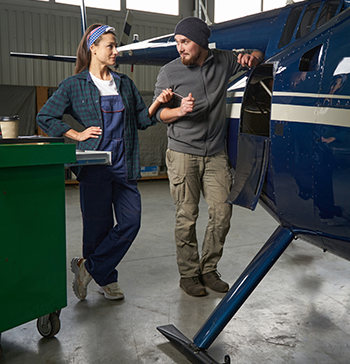
Want to find out more about our Aviation Mechanic Courses?
Download our free eBook to learn everything about aviation mechanic courses at Aero Wave Aviation and Maintenance School. Discover the qualifications required, the training process, available programs, and the career opportunities awaiting you. Take the first step toward a fulfilling career in aviation maintenance today!


